Blue Water Tracks
Yacht race tracking.
Yacht racing and rally organises now have a very cost effective way to provide a public race map. Families, friends and the media can follow along with the action, including replays, boat and crew bio's with hero photos. Through the Blue Water Tracks portal, race and rally organiser have a full management dashboard that enables them to quick setup and easily control every aspect of the tracked progress along with the public map showing leaderboards and race statistics.
Crew Manage crew photos and bio
Graphs Compare boat performance
Leader Boards Display the boats race position
Boat Manage boat details and photos
Trackers Use low cost trackers
Handicaps Unlimited handicaps
Replay Replay the race
Admin Simple administration and full control of the race
Race page Public race page

ADMIN INTERFACE
Public race page.
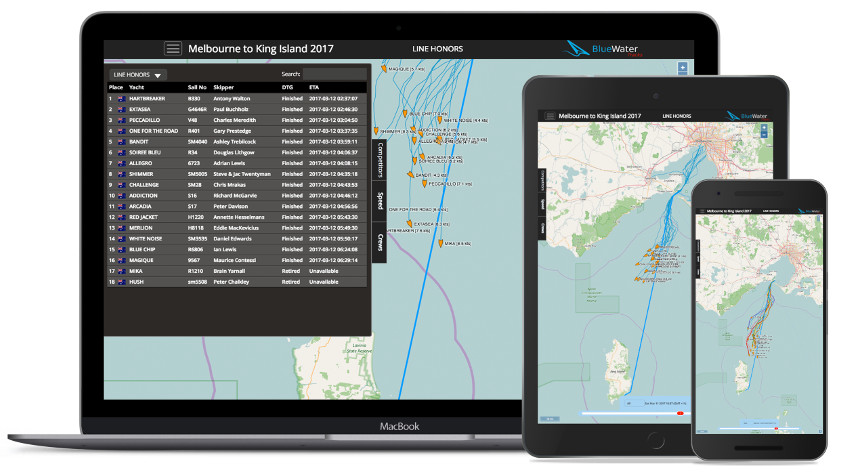
GETTING STARTED
Purchase your inReach trackers from Amazon . If using the phone app, go to step three
Activate your inReach device with Delorme
Sign up for your race organisers account account here
Add your trackers, crews and boats into your Blue Water Tracks account
Create a race and assign each boat a tracker
Publish the public race page link
Once the the race is set up, Blue Water Tracks will collect the positions and vector data from each tracker and display the boats progress through the live public race page.

List of current races
| Race Name | Start Time | Distance | Boats | Crews | Location |
|---|---|---|---|---|---|
| 2024-03-09 03:00 | 114 | 33 | 187 | Australia | |
| 2023-12-27 13:00 | 440 | 15 | 99 | Australia | |
| 2023-11-03 18:00 | 195 | 32 | 137 | Australia | |
| 2023-03-10 17:00 | 114 | 32 | 240 | Australia | |
| 2022-12-27 12:00 | 440 | 50 | 350 | Australia | |
| 2022-03-11 15:00 | 114 | 41 | 276 | Australia | |
| 2021-12-27 14:30 | 440 | 9 | 57 | Australia | |
| 2021-12-27 14:30 | 195 | 5 | 23 | Australia | |
| 2021-04-02 06:30 | 135 | 8 | 44 | Australia | |
| 2021-03-21 01:45 | 114 | 30 | 203 | Australia | |
| 2020-12-27 11:15 | 195 | 22 | 129 | Australia | |
| 2020-03-07 00:30 | 114 | 22 | 152 | Australia | |
| 2019-12-27 14:30 | 440 | 6 | 31 | Australia | |
| 2019-12-27 14:30 | 195 | 10 | 57 | Australia | |
| 2019-11-02 00:05 | 152 | 22 | 175 | Australia | |
| 2019-09-21 10:00 | 283 | 8 | 20 | Australia | |
| 2019-06-29 11:00 | 646 | 20 | 20 | Danmark | |
| 2019-03-08 23:00 | 114 | 22 | 161 | Australia | |
| 2018-12-27 09:00 | 440 | 12 | 80 | Australia | |
| 2018-12-27 09:00 | 195 | 11 | 71 | Australia | |
| 2018-11-03 10:00 | 152 | 14 | 110 | Australia | |
| 2018-03-30 01:00 | 135 | 4 | 24 | Australia | |
| 2018-03-15 14:00 | 5000 | 19 | 38 | Pacific | |
| 2018-03-10 01:00 | 114 | 18 | 122 | Australia | |
| 2017-12-27 14:30 | 440 | 21 | 180 | Australia | |
| 2017-12-27 14:30 | 195 | 11 | 75 | Australia | |
| 2017-11-04 02:00 | 152 | 18 | 131 | Australia | |
| 2017-04-14 03:35 | 38 | 5 | 29 | Australia | |
| 2017-04-14 03:30 | 135 | 7 | 37 | Australia | |
| 2017-03-11 01:30 | 114 | 18 | 139 | Australia | |
| 2016-12-27 11:30 | 440 | 10 | 77 | Australia | |
| 2016-12-27 11:30 | 195 | 11 | 71 | Australia | |
| 2016-10-29 02:15 | 152 | 19 | 136 | Australia | |
| 2016-03-25 15:00 | 135 | 9 | 56 | Australia | |
| 2016-03-12 10:00 | 114 | 22 | 180 | Australia | |
| 2015-12-29 10:00 | 195 | 7 | 55 | Australia | |
| 2015-12-28 10:00 | 440 | 9 | 52 | Australia | |
| 2015-10-31 10:00 | 152 | 18 | 125 | Australia |
The Blue Water Tracks service is provided free of charge to yacht racing organisations. The service is funded by the philanthropy of the Dunoon Family Trust to ensure the highest level of infrastructure and service quality. Significant resource has been made available in the development of this service, ensuring that every race organiser has the tools needed for an effortless race tracking experience that enhances safety for all competitors.
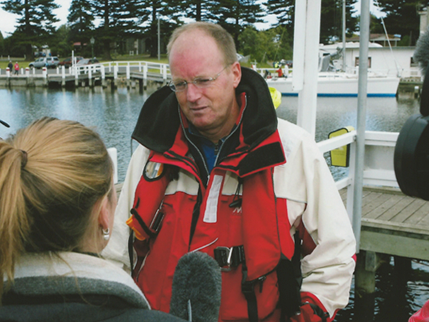
Grant Dunoon
Grant Dunoon founded Blue Water Tracks to deliver a service to yacht racing organisation and at the same time make safety affordable for every competitor.
In 2012 Grant was the skipper who rescued 6 crew when their yacht sank suddenly after the loss of their liferaft just before midnight during a devastating storm that wiped out the Melbourne to Port Fairy yacht race. Read more about it here .
Grant has be honoured with the Queen's Group Bravery Award, Australian National Search and Rescue Council Award, Yachting Australia (Australian Sailing) SOLAS Trust Award, Yachting Victoria's President's Awards, Royal Bright Yacht Club's Commodore's Awards. ORCV Ocean Racer of the Year.
Raju Maisnam
Dmytro Hrytsenko
Bhargav Konkathi
Ilya Alekseev
Documentation
Margo Kerdikoshvili
Graphic Designer
TESTIMONIALS

“We have found the service to be very reliable and the management portal simple to use. It has and is saving our club thousands of dollars each year and at the same time delivers an invaluable service to our members."
Simon Dryden
Ocean Racing Club Victoria

MELBOURNE OSAKA CUP

BLUE WATER TRACKS

Skipper:Grant Dunoon
Co-skipper:sue bumstead, sail number:s1, design:moody 54ds.

- Yachting World
- Digital Edition

43 of the best bluewater sailboat designs of all time
- January 5, 2022
How do you choose the right yacht for you? We highlight the very best bluewater sailboat designs for every type of cruising

Which yacht is the best for bluewater boating? This question generates even more debate among sailors than questions about what’s the coolest yacht , or the best for racing. Whereas racing designs are measured against each other, cruising sailors get very limited opportunities to experience different yachts in real oceangoing conditions, so what is the best bluewater sailboat?
Here, we bring you our top choices from decades of designs and launches. Over the years, the Yachting World team has sailed these boats, tested them or judged them for European Yacht of the Year awards, and we have sifted through the many to curate a selection that we believe should be on your wishlist.
Making the right choice may come down to how you foresee your yacht being used after it has crossed an ocean or completed a passage: will you be living at anchor or cruising along the coast? If so, your guiding requirements will be space, cabin size, ease of launching a tender and anchoring closer to shore, and whether it can comfortably accommodate non-expert-sailor guests.
Article continues below…

The perfect boat: what makes an ideal offshore cruising yacht?
Choosing a boat for offshore cruising is not a decision to be taken lightly. I have researched this topic on…

European Yacht of the Year 2019: Best luxury cruisers
Before the sea trials began, I would have put money on a Hallberg-Rassy or the Wauquiez winning an award. The…
All of these considerations have generated the inexorable rise of the bluewater catamaran – monohulls can’t easily compete on these points. We have a full separate feature on the best bluewater multihulls of all time and here we mostly focus on monohulls. The only exceptions to that rule are two multihulls which made it into our best bluewater sailboats of 2022 list.
As so much of making the right choice is selecting the right boat for the venture in mind, we have separated out our edit into categories: best for comfort; for families; for performance; and for expedition or high latitudes sailing .
Best bluewater sailboats of 2022
The new flagship Allures 51.9, for example, is a no-nonsense adventure cruising design built and finished to a high standard. It retains Allures’ niche of using aluminium hulls with glassfibre decks and superstructures, which, the yard maintains, gives the optimum combination of least maintenance and less weight higher up. Priorities for this design were a full beam aft cabin and a spacious, long cockpit. Both are excellent, with the latter, at 6m long, offering formidable social, sailing and aft deck zones.
It likes some breeze to come to life on the wheel, but I appreciate that it’s designed to take up to five tonnes payload. And I like the ease with which you can change gears using the furling headsails and the positioning of the powerful Andersen winches inboard. The arch is standard and comes with a textile sprayhood or hard bimini.
Below decks you’ll find abundant headroom and natural light, a deep U-shape galley and cavernous stowage. For those who like the layout of the Amel 50 but would prefer aluminium or shoal draught, look no further.
Allures 51.9 price: €766,000
The Ovni 370 is another cunning new aluminum centreboard offering, a true deck saloon cruiser for two. The designers say the biggest challenge was to create a Category A ocean going yacht at this size with a lifting keel, hence the hull had to be very stable.
Enjoyable to helm, it has a practical, deep cockpit behind a large sprayhood, which can link to the bimini on the arch. Many of its most appealing features lie in the bright, light, contemporary, clever, voluminous interior, which has good stowage and tankage allocation. There’s also a practical navstation, a large workroom and a vast separate shower. I particularly like the convertible saloom, which can double as a large secure daybed or pilot berth.
Potentially the least expensive Category A lift keel boat available, the Ovni will get you dreaming of remote places again.
Ovni 370 price: €282,080

There’s no shortage of spirit in the Windelo 50. We gave this a sustainability award after it’s founders spent two years researching environmentally-friendly composite materials, developing an eco-composite of basalt fibre and recycled PET foam so it could build boats that halve the environmental impact of standard glassfibre yachts.
The Windelo 50 is an intriguing package – from the styling, modular interior and novel layout to the solar field on the roof and the standard electric propulsion, it is completely fresh.
Windelo 50 price: €795,000
Best bluewater sailboat of 2022 – Outremer 55
I would argue that this is the most successful new production yacht on the market. Well over 50 have already sold (an equipped model typically costs €1.6m) – and I can understand why. After all, were money no object, I had this design earmarked as the new yacht I would most likely choose for a world trip.
Indeed 55 number one Sanya, was fully equipped for a family’s world cruise, and left during our stay for the Grand Large Odyssey tour. Whereas we sailed Magic Kili, which was tricked up with performance options, including foam-cored deckheads and supports, carbon crossbeam and bulkheads, and synthetic rigging.
At rest, these are enticing space ships. Taking one out to sea is another matter though. These are speed machines with the size, scale and loads to be rightly weary of. Last month Nikki Henderson wrote a feature for us about how to manage a new breed of performance cruising cats just like this and how she coaches new owners. I could not think of wiser money spent for those who do not have ample multihull sailing experience.
Under sail, the most fun was obviously reserved for the reaching leg under asymmetric, where we clocked between 11-16 knots in 15-16 knots wind. But it was the stability and of those sustained low teen speeds which really hit home – passagemaking where you really cover miles.
Key features include the swing helms, which give you views from outboard, over the coachroof or from a protected position in the cockpit through the coachroof windows, and the vast island in the galley, which is key to an open plan main living area. It helps provide cavernous stowage and acts as the heart of the entertaining space as it would in a modern home. As Danish judge Morten Brandt-Rasmussen comments: “Apart from being the TGV of ocean passages the boat offers the most spacious, open and best integration of the cockpit and salon areas in the market.”
Outremer has done a top job in packing in the creature comforts, stowage space and payload capacity, while keeping it light enough to eat miles. Although a lot to absorb and handle, the 55 offers a formidable blend of speed and luxury cruising.
Outremer 55 price: €1.35m
Best bluewater sailboats for comfort
This is the successor to the legendary Super Maramu, a ketch design that for several decades defined easy downwind handling and fostered a cult following for the French yard. Nearly a decade old, the Amel 55 is the bridge between those world-girdling stalwarts and Amel’s more recent and totally re-imagined sloop designs, the Amel 50 and 60.
The 55 boasts all the serious features Amel aficionados loved and valued: a skeg-hung rudder, solidly built hull, watertight bulkheads, solid guardrails and rampart bulwarks. And, most noticeable, the solid doghouse in which the helmsman sits in perfect shelter at the wheel.
This is a design to live on comfortably for long periods and the list of standard features just goes on and on: passarelle; proper sea berths with lee cloths; electric furling main and genoa; and a multitude of practical items that go right down to a dishwasher and crockery.
There’s no getting around the fact these designs do look rather dated now, and through the development of easier sail handling systems the ketch rig has fallen out of fashion, but the Amel is nothing short of a phenomenon, and if you’ve never even peeked on board one, you really have missed a treat.

Photo: Sander van der Borch
Contest 50CS
A centre cockpit cruiser with true longevity, the Contest 50CS was launched by Conyplex back in 2003 and is still being built by the family-owned Dutch company, now in updated and restyled form.
With a fully balanced rudder, large wheel and modern underwater sections, the Contest 50CS is a surprisingly good performer for a boat that has a dry weight of 17.5 tonnes. Many were fitted with in-mast furling, which clearly curtails that performance, but even without, this boat is set up for a small crew.
Electric winches and mainsheet traveller are all easy to reach from the helm. On our test of the Contest 50CS, we saw for ourselves how two people can gybe downwind under spinnaker without undue drama. Upwind, a 105% genoa is so easy to tack it flatters even the weediest crewmember.
Down below, the finish level of the joinery work is up there among the best and the interior is full of clever touches, again updated and modernised since the early models. Never the cheapest bluewater sailing yacht around, the Contest 50CS has remained in demand as a brokerage buy. She is a reassuringly sure-footed, easily handled, very well built yacht that for all those reasons has stood the test of time.
This is a yacht that would be well capable of helping you extend your cruising grounds, almost without realising it.
Read more about the Contest 50CS and the new Contest 49CS

Photo: Rick Tomlinson
Hallberg-Rassy 48 Mk II
For many, the Swedish Hallberg-Rassy yard makes the quintessential bluewater cruiser for couples. With their distinctive blue cove line, these designs are famous for their seakindly behaviour, solid-as-a-rock build and beautifully finished, traditional interiors.
To some eyes, Hallberg-Rassys aren’t quite cool enough, but it’s been company owner Magnus Rassy’s confidence in the formula and belief in incremental ‘step-by-step’ evolution that has been such an exceptional guarantor of reliable quality, reputation and resale value.
The centre cockpit Hallberg-Rassy 48 epitomises the concept of comfort at sea and, like all the Frers-designed Hallberg-Rassys since the 1990s, is surprisingly fleet upwind as well as steady downwind. The 48 is perfectly able to be handled by a couple (as we found a few years back in the Pacific), and could with no great effort crack out 200-mile days.
The Hallberg-Rassy 48 was launched nearly a decade ago, but the Mk II from 2014 is our pick, updated with a more modern profile, larger windows and hull portlights that flood the saloon and aft cabin with light. With a large chart table, secure linear galley, heaps of stowage and space for bluewater extras such as machinery and gear, this yacht pretty much ticks all the boxes.

Discovery 55
First launched in 2000, the Discovery 55 has stood the test of time. Designed by Ron Holland, it hit a sweet spot in size that appealed to couples and families with world girdling plans.
Elegantly styled and well balanced, the 55 is also a practical design, with a deep and secure cockpit, comfortable seating, a self-tacking jib, dedicated stowage for the liferaft , a decent sugar scoop transom that’s useful for swimming or dinghy access, and very comfortable accommodation below. In short, it is a design that has been well thought out by those who’ve been there, got the bruises, stubbed their toes and vowed to change things in the future if they ever got the chance.
Throughout the accommodation there are plenty of examples of good detailing, from the proliferation of handholds and grabrails, to deep sinks in the galley offering immediate stowage when under way and the stand up/sit down showers. Stowage is good, too, with plenty of sensibly sized lockers in easily accessible positions.
The Discovery 55 has practical ideas and nifty details aplenty. She’s not, and never was, a breakthrough in modern luxury cruising but she is pretty, comfortable to sail and live on, and well mannered.

Photo: Latitudes Picture Library
You can’t get much more Cornish than a Rustler. The hulls of this Stephen Jones design are hand-moulded and fitted out in Falmouth – and few are more ruggedly built than this traditional, up-for-anything offshore cruiser.
She boasts an encapsulated lead keel, eliminating keel bolts and creating a sump for generous fuel and water tankage, while a chunky skeg protects the rudder. She is designed for good directional stability and load carrying ability. These are all features that lend this yacht confidence as it shoulders aside the rough stuff.
Most of those built have had a cutter rig, a flexible arrangement that makes sense for long passages in all sea and weather conditions. Down below, the galley and saloon berths are comfortable and sensible for living in port and at sea, with joinery that Rustler’s builders are rightly proud of.
As modern yachts have got wider, higher and fatter, the Rustler 42 is an exception. This is an exceptionally well-mannered seagoing yacht in the traditional vein, with elegant lines and pleasing overhangs, yet also surprisingly powerful. And although now over 20 years old, timeless looks and qualities mean this design makes her look ever more like a perennial, a modern classic.
The definitive crossover size, the point at which a yacht can be handled by a couple but is just large enough to have a professional skipper and be chartered, sits at around the 60ft mark. At 58ft 8in, the Oyster 575 fitted perfectly into this growing market when launched in 2010. It went on to be one of the most popular models from the yard, and is only now being superseded by the newer Rob Humphreys-designed Oyster 565 (just launched this spring).
Built in various configurations with either a deep keel, shoal draught keel or centreboard with twin rudders, owners could trade off better performance against easy access to shallower coves and anchorages. The deep-bodied hull, also by Rob Humphreys, is known for its easy motion at sea.
Some of the Oyster 575’s best features include its hallmark coachroof windows style and centre cockpit – almost everyone will know at first glance this is an Oyster – and superb interior finish. If she has a flaw, it is arguably the high cockpit, but the flip side is the galley headroom and passageway berth to the large aft stateroom.
This design also has a host of practical features for long-distance cruising, such as high guardrails, dedicated liferaft stowage, a vast lazarette for swallowing sails, tender, fenders etc, and a penthouse engine room.

Privilege Serie 5
A true luxury catamaran which, fully fitted out, will top €1m, this deserves to be seen alongside the likes of the Oyster 575, Gunfleet 58 and Hallberg-Rassy 55. It boasts a large cockpit and living area, and a light and spacious saloon with an emphasis on indoor-outdoor living, masses of refrigeration and a big galley.
Standout features are finish quality and solid build in a yacht designed to take a high payload, a secure walkaround deck and all-round views from the helm station. The new Privilege 510 that will replace this launches in February 2020.
Gunfleet 43
It was with this Tony Castro design that Richard Matthews, founder of Oyster Yachts, launched a brand new rival brand in 2012, the smallest of a range stretching to the flagship Gunfleet 74. The combination of short overhangs and centre cockpit at this size do make the Gunfleet 43 look modern if a little boxy, but time and subsequent design trends have been kind to her lines, and the build quality is excellent. The saloon, galley and aft cabin space is exceptional on a yacht of this size.

Photo: David Harding
Conceived as a belt-and-braces cruiser, the Kraken 50 launched last year. Its unique points lie underwater in the guise of a full skeg-hung rudder and so-called ‘Zero Keel’, an encapsulated long keel with lead ballast.
Kraken Yachts is the brainchild of British businessman and highly experienced cruiser Dick Beaumont, who is adamant that safety should be foremost in cruising yacht design and build. “There is no such thing as ‘one yacht for all purposes’… You cannot have the best of all worlds, whatever the salesman tells you,” he says.
Read our full review of the Kraken 50 .

Wauquiez Centurion 57
Few yachts can claim to be both an exciting Med-style design and a serious and practical northern European offshore cruiser, but the Wauquiez Centurion 57 tries to blend both. She slightly misses if you judge solely by either criterion, but is pretty and practical enough to suit her purpose.
A very pleasant, well-considered yacht, she is impressively built and finished with a warm and comfortable interior. More versatile than radical, she could be used for sailing across the Atlantic in comfort and raced with equal enjoyment at Antigua Sailing Week .

A modern classic if ever there was one. A medium to heavy displacement yacht, stiff and easily capable of standing up to her canvas. Pretty, traditional lines and layout below.

Photo: Voyage of Swell
Well-proven US legacy design dating back to the mid-1960s that once conquered the Transpac Race . Still admired as pretty, with slight spoon bow and overhanging transom.

Capable medium displacement cruiser, ideal size and good accommodation for couples or family cruising, and much less costly than similar luxury brands.

Photo: Peter Szamer
Swedish-built aft cockpit cruiser, smaller than many here, but a well-built and finished, super-durable pocket ocean cruiser.

Tartan 3700
Designed as a performance cruiser there are nimbler alternatives now, but this is still an extremely pretty yacht.
Broker ’ s choice

Discovery 55 Brizo
This yacht has already circumnavigated the globe and is ‘prepared for her next adventure,’ says broker Berthon. Price: £535,000 + VAT

Oyster 575 Ayesha
‘Stunning, and perfectly equipped for bluewater cruising,’ says broker Ancasta International. Price: £845,000 (tax not paid)

Oyster 575 Pearls of Nautilus
Nearly new and with a high spec, this Oyster Brokerage yacht features American white oak joinery and white leather upholstery and has a shoal draught keel. Price: $1.49m
Best bluewater yachts for performance
The Frers-designed Swan 54 may not be the newest hull shape but heralded Swan’s latest generation of displacement bluewater cruisers when launched four years ago. With raked stem, deep V hull form, lower freeboard and slight curve to the topsides she has a more timeless aesthetic than many modern slab-sided high volume yachts, and with that a seakindly motion in waves. If you plan to cover many miles to weather, this is probably the yacht you want to be on.

Photo: Carlo Borlenghi
Besides Swan’s superlative build quality, the 54 brings many true bluewater features, including a dedicated sail locker. There’s also a cockpit locker that functions as a utility cabin, with potential to hold your generator and washing machine, or be a workshop space.
The sloping transom opens out to reveal a 2.5m bathing platform, and although the cabins are not huge there is copious stowage space. Down below the top-notch oak joinery is well thought through with deep fiddles, and there is a substantial nav station. But the Swan 54 wins for handling above all, with well laid-out sail controls that can be easily managed between a couple, while offering real sailing enjoyment to the helmsman.

Photo: Graham Snook
The Performance Cruiser winner at the 2019 European Yacht of the Year awards, the Arcona 435 is all about the sailing experience. She has genuine potential as a cruiser-racer, but her strengths are as an enjoyable cruiser rather than a full-blown liveaboard bluewater boat.
Build quality is excellent, there is the option of a carbon hull and deck, and elegant lines and a plumb bow give the Arcona 435 good looks as well as excellent performance in light airs. Besides slick sail handling systems, there are well thought-out features for cruising, such as ample built-in rope bins and an optional semi-closed stern with stowage and swim platform.

Outremer 51
If you want the space and stability of a cat but still prioritise sailing performance, Outremer has built a reputation on building catamarans with true bluewater characteristics that have cruised the planet for the past 30 years.
Lighter and slimmer-hulled than most cruising cats, the Outremer 51 is all about sailing at faster speeds, more easily. The lower volume hulls and higher bridgedeck make for a better motion in waves, while owners report that being able to maintain a decent pace even under reduced canvas makes for stress-free passages. Deep daggerboards also give good upwind performance.
With bucket seats and tiller steering options, the Outremer 51 rewards sailors who want to spend time steering, while they’re famously well set up for handling with one person on deck. The compromise comes with the interior space – even with a relatively minimalist style, there is less cabin space and stowage volume than on the bulkier cats, but the Outremer 51 still packs in plenty of practical features.

The Xc45 was the first cruising yacht X-Yachts ever built, and designed to give the same X-Yachts sailing experience for sailors who’d spent years racing 30/40-footer X- and IMX designs, but in a cruising package.
Launched over 10 years ago, the Xc45 has been revisited a few times to increase the stowage and modernise some of the styling, but the key features remain the same, including substantial tanks set low for a low centre of gravity, and X-Yachts’ trademark steel keel grid structure. She has fairly traditional styling and layout, matched with solid build quality.
A soft bilge and V-shaped hull gives a kindly motion in waves, and the cockpit is secure, if narrow by modern standards.

A three or four cabin catamaran that’s fleet of foot with high bridgedeck clearance for comfortable motion at sea. With tall daggerboards and carbon construction in some high load areas, Catana cats are light and quick to accelerate.

Sweden Yachts 45
An established bluewater design that also features in plenty of offshore races. Some examples are specced with carbon rig and retractable bowsprits. All have a self-tacking jib for ease. Expect sweeping areas of teak above decks and a traditionally wooded interior with hanging wet locker.

A vintage performer, first launched in 1981, the 51 was the first Frers-designed Swan and marked a new era of iconic cruiser-racers. Some 36 of the Swan 51 were built, many still actively racing and cruising nearly 40 years on. Classic lines and a split cockpit make this a boat for helming, not sunbathing.

Photo: Julien Girardot / EYOTY
The JPK 45 comes from a French racing stable, combining race-winning design heritage with cruising amenities. What you see is what you get – there are no superfluous headliners or floorboards, but there are plenty of ocean sailing details, like inboard winches for safe trimming. The JPK 45 also has a brilliantly designed cockpit with an optional doghouse creating all-weather shelter, twin wheels and superb clutch and rope bin arrangement.

Photo: Andreas Lindlahr
For sailors who don’t mind exchanging a few creature comforts for downwind planing performance, the Pogo 50 offers double-digit surfing speeds for exhilarating tradewind sailing. There’s an open transom, tiller steering and no backstay or runners. The Pogo 50 also has a swing keel, to nose into shallow anchorages.

Seawind 1600
Seawinds are relatively unknown in Europe, but these bluewater cats are very popular in Australia. As would be expected from a Reichel-Pugh design, this 52-footer combines striking good looks and high performance, with fine entry bows and comparatively low freeboard. Rudders are foam cored lifting designs in cassettes, which offer straightforward access in case of repairs, while daggerboards are housed under the deck.
Best bluewater sailboats for families
It’s unsurprising that, for many families, it’s a catamaran that meets their requirements best of increased space – both living space and separate cabins for privacy-seeking teenagers, additional crew or visiting family – as well as stable and predictable handling.

Photo: Nicholas Claris
Undoubtedly one of the biggest success stories has been the Lagoon 450, which, together with boats like the Fountaine Pajot 44, helped drive up the popularity of catamaran cruising by making it affordable and accessible. They have sold in huge numbers – over 1,000 Lagoon 450s have been built since its launch in 2010.
The VPLP-designed 450 was originally launched with a flybridge with a near central helming position and upper level lounging areas (450F). The later ‘sport top’ option (450S) offered a starboard helm station and lower boom (and hence lower centre of gravity for reduced pitching). The 450S also gained a hull chine to create additional volume above the waterline. The Lagoon features forward lounging and aft cockpit areas for additional outdoor living space.
Besides being a big hit among charter operators, Lagoons have proven themselves over thousands of bluewater miles – there were seven Lagoon 450s in last year’s ARC alone. In what remains a competitive sector of the market, Lagoon has recently launched a new 46, with a larger self-tacking jib and mast moved aft, and more lounging areas.

Photo: Gilles Martin-Raget
Fountaine Pajot Helia 44
The FP Helia 44 is lighter, lower volume, and has a lower freeboard than the Lagoon, weighing in at 10.8 tonnes unloaded (compared to 15 for the 450). The helm station is on a mezzanine level two steps up from the bridgedeck, with a bench seat behind. A later ‘Evolution’ version was designed for liveaboard cruisers, featuring beefed up dinghy davits and an improved saloon space.
Available in three or four cabin layouts, the Helia 44 was also popular with charter owners as well as families. The new 45 promises additional volume, and an optional hydraulically lowered ‘beach club’ swim platform.

Photo: Arnaud De Buyzer / graphikup.com
The French RM 1370 might be less well known than the big brand names, but offers something a little bit different for anyone who wants a relatively voluminous cruising yacht. Designed by Marc Lombard, and beautifully built from plywood/epoxy, the RM is stiff and responsive, and sails superbly.
The RM yachts have a more individual look – in part down to the painted finish, which encourages many owners to personalise their yachts, but also thanks to their distinctive lines with reverse sheer and dreadnought bow. The cockpit is well laid out with the primary winches inboard for a secure trimming position. The interior is light, airy and modern, although the open transom won’t appeal to everyone.
For those wanting a monohull, the Hanse 575 hits a similar sweet spot to the popular multis, maximising accommodation for a realistic price, yet with responsive performance.
The Hanse offers a vast amount of living space thanks to the ‘loft design’ concept of having all the living areas on a single level, which gives a real feeling of spaciousness with no raised saloon or steps to accommodation. The trade-off for such lofty head height is a substantial freeboard – it towers above the pontoon, while, below, a stepladder is provided to reach some hatches.
Galley options include drawer fridge-freezers, microwave and coffee machine, and the full size nav station can double up as an office or study space.
But while the Hanse 575 is a seriously large boat, its popularity is also down to the fact that it is genuinely able to be handled by a couple. It was innovative in its deck layout: with a self-tacking jib and mainsheet winches immediately to hand next to the helm, one person could both steer and trim.
Direct steering gives a feeling of control and some tangible sailing fun, while the waterline length makes for rapid passage times. In 2016 the German yard launched the newer Hanse 588 model, having already sold 175 of the 575s in just four years.

Photo: Bertel Kolthof
Jeanneau 54
Jeanneau leads the way among production builders for versatile all-rounder yachts that balance sail performance and handling, ergonomics, liveaboard functionality and good looks. The Jeanneau 54 , part of the range designed by Philippe Briand with interior by Andrew Winch, melds the best of the larger and smaller models and is available in a vast array of layout options from two cabins/two heads right up to five cabins and three heads.
We’ve tested the Jeanneau 54 in a gale and very light winds, and it acquitted itself handsomely in both extremes. The primary and mainsheet winches are to hand next to the wheel, and the cockpit is spacious, protected and child-friendly. An electric folding swim and sun deck makes for quick fun in the water.

Nautitech Open 46
This was the first Nautitech catamaran to be built under the ownership of Bavaria, designed with an open-plan bridgedeck and cockpit for free-flowing living space. But with good pace for eating up bluewater miles, and aft twin helms rather than a flybridge, the Nautitech Open 46 also appeals to monohull sailors who prefer a more direct sailing experience.

Made by Robertson and Caine, who produce catamarans under a dual identity as both Leopard and the Sunsail/Moorings charter cats, the Leopard 45 is set to be another big seller. Reflecting its charter DNA, the Leopard 45 is voluminous, with stepped hulls for reduced waterline, and a separate forward cockpit.
Built in South Africa, they are robustly tested off the Cape and constructed ruggedly enough to handle heavy weather sailing as well as the demands of chartering.

Photo: Olivier Blanchet
If space is king then three hulls might be even better than two. The Neel 51 is rare as a cruising trimaran with enough space for proper liveaboard sailing. The galley and saloon are in the large central hull, together with an owner’s cabin on one level for a unique sensation of living above the water. Guest or family cabins lie in the outer hulls for privacy and there is a cavernous full height engine room under the cabin sole.
Performance is notably higher than an equivalent cruising cat, particularly in light winds, with a single rudder giving a truly direct feel in the helm, although manoeuvring a 50ft trimaran may daunt many sailors.

Beneteau Oceanis 46.1
A brilliant new model from Beneteau, this Finot Conq design has a modern stepped hull, which offers exhilarating and confidence-inspiring handling in big breezes, and slippery performance in lighter winds.
The Beneteau Oceanis 46.1 was the standout performer at this year’s European Yacht of the Year awards, and, in replacing the popular Oceanis 45, looks set to be another bestseller. Interior space is well used with a double island berth in the forepeak. An additional inboard unit creates a secure galley area, but tank capacity is moderate for long periods aboard.

Beneteau Oceanis 473
A popular model that offers beam and height in a functional layout, although, as with many boats of this age (she was launched in 2002), the mainsheet is not within reach of the helmsman.

Jeanneau Sun Odyssey 49
The Philippe Briand-designed Sun Odyssey range has a solid reputation as family production cruisers. Like the 473, the Sun Odyssey 49 was popular for charter so there are plenty of four-cabin models on the market.

Nautitech 441
The hull design dates back to 1995, but was relaunched in 2012. Though the saloon interior has dated, the 441 has solid practical features, such as a rainwater run-off collection gutter around the coachroof.

Atlantic 42
Chris White-designed cats feature a pilothouse and forward waist-high working cockpit with helm position, as well as an inside wheel at the nav station. The Atlantic 42 offers limited accommodation by modern cat standards but a very different sailing experience.
Best bluewater sailing yachts for expeditions
Bestevaer 56.
All of the yachts in our ‘expedition’ category are aluminium-hulled designs suitable for high latitude sailing, and all are exceptional yachts. But the Bestevaer 56 is a spectacular amount of boat to take on a true adventure. Each Bestevaer is a near-custom build with plenty of bespoke options for owners to customise the layout and where they fall on the scale of rugged off-grid adventurer to 4×4-style luxury fit out.

The Bestevaer range began when renowned naval architect Gerard Dijkstra chose to design his own personal yacht for liveaboard adventure cruising, a 53-footer. The concept drew plenty of interest from bluewater sailors wanting to make longer expeditions and Bestevaers are now available in a range of sizes, with the 56-footer proving a popular mid-range length.
The well-known Bestevaer 56 Tranquilo (pictured above) has a deep, secure cockpit, voluminous tanks (700lt water and over 1,100lt fuel) and a lifting keel plus water ballast, with classically styled teak clad decks and pilot house. Other owners have opted for functional bare aluminium hull and deck, some choose a doghouse and others a pilothouse.

Photo: Jean-Marie Liot
The Boreal 52 also offers Land Rover-esque practicality, with utilitarian bare aluminium hulls and a distinctive double-level doghouse/coachroof arrangement for added protection in all weathers. The cockpit is clean and uncluttered, thanks to the mainsheet position on top of the doghouse, although for visibility in close manoeuvring the helmsman will want to step up onto the aft deck.
Twin daggerboards, a lifting centreboard and long skeg on which she can settle make this a true go-anywhere expedition yacht. The metres of chain required for adventurous anchoring is stowed in a special locker by the mast to keep the weight central. Down below has been thought through with equally practical touches, including plenty of bracing points and lighting that switches on to red light first to protect your night vision.

Photo: Morris Adant / Garcia Yachts
Garcia Exploration 45
The Garcia Exploration 45 comes with real experience behind her – she was created in association with Jimmy Cornell, based on his many hundreds of thousands of miles of bluewater cruising, to go anywhere from high latitudes to the tropics.
Arguably less of a looker than the Bestevaer, the Garcia Exploration 45 features a rounded aluminium hull, centreboard with deep skeg and twin daggerboards. The considerable anchor chain weight has again been brought aft, this time via a special conduit to a watertight locker in front of the centreboard.
This is a yacht designed to be lived on for extended periods with ample storage, and panoramic portlights to give a near 360° view of whichever extraordinary landscape you are exploring. Safety features include a watertight companionway door to keep extreme weather out and through-hull fittings placed above the waterline. When former Vendée Globe skipper Pete Goss went cruising , this was the boat he chose to do it in.

Photo: svnaima.com
A truly well-proven expedition design, some 1,500 Ovnis have been built and many sailed to some of the most far-flung corners of the world. (Jimmy Cornell sailed his Aventura some 30,000 miles, including two Drake Passage crossings, one in 50 knots of wind).

Futuna Exploration 54
Another aluminium design with a swinging centreboard and a solid enclosed pilothouse with protected cockpit area. There’s a chunky bowsprit and substantial transom arch to house all manner of electronics and power generation.
Previous boats have been spec’d for North West Passage crossings with additional heating and engine power, although there’s a carbon rig option for those that want a touch of the black stuff. The tanks are capacious, with 1,000lt capability for both fresh water and fuel.
If you enjoyed this….
Yachting World is the world’s leading magazine for bluewater cruisers and offshore sailors. Every month we have inspirational adventures and practical features to help you realise your sailing dreams. Build your knowledge with a subscription delivered to your door. See our latest offers and save at least 30% off the cover price.
Rolex Sydney Hobart Yacht Race 2024

Blue Water Tracks
/media/3440218/blue-water-tracks.jpg)
Formerly known as Trybooking.com, Grant Dunoon and crew retired the Moody 54DS from its last Rolex Sydney Hobart in 2015, after damaging the bow thruster, but finished the 2014 race PHS 16th overall. Last year, he and Sue Bumstead finished Australia’s longest ocean race, the 5500nm double-handed Melbourne Osaka race, PHS 16th overall. Joining the crew this year are Annette Hesselmans and her husband Gerard Snijders, who also did the Melbourne Osaka last year, and two totally unrelated guys by the name of Paul Jenkins! This luxury boat boasts four main cabins and accommodates a crew of 12. In 2012, Dunoon and three crew members received the AMSA SAR (Search and Rescue) award after risking their lives to rescue survivors from a sunken competitor in the Melbourne Port Fairy Race, battling huge swells and gusts of up to 70 knots in the middle of the night.
Competitor Details
| Yacht Name | Blue Water Tracks |
| Sail Number | B1 |
| Owner | Grant Dunoon |
| Skipper | Grant Dunoon |
| Navigator | Neville Rose |
| Crew | P Jenkins, P Jenkins Jnr., N Rose, M Wilson, A Hesselmans, G Snijders |
| State | VIC |
| Club | RBYC |
| Type | Moody DS54 |
| Designer | Dixon Yacht Design |
| Builder | Moody |
| Construction | GRP |
| LOA | 17.2 |
| Beam | 5.2 |
| Draft | 2.6 |
OFFICIAL ROLEX SYDNEY HOBART MERCHANDISE
Shop the official clothing range of the Rolex Sydney Hobart Yacht Race and the Cruising Yacht Club of Australia in person at the Club in New South Head Road, Darling Point or online below.
From casual to technical clothing, there is something for all occasions. Be quick as stock is limited!
Audi Centre Sydney Blue Water Pointscore 24/25
- About the Blue Water Pointscore
- The History
The 2024 Audi Centre Sydney Blue Water Pointscore consists of six races, opening with the Noakes Sydney Gold Coast Yacht Race and finishing with the Rolex Sydney Hobart Yacht Race.
Points accrued across the six races will determine the winners of the overall Pointscores, including:
- Audi Centre Sydney Blue Water Pointscore (awarded to the overall IRC winner)
- Tasman Performance Series (awarded to the overall PHS winner)
- Bass & Flinders Series (awarded to the overall scratch winner)
- Wild Rose Pointscore (encourages female participation across all boats in the Audi Centre Sydney Blue Water Pointscore)
NOTE: Below are the provisional race dates, which will be confirmed in due course.
Race 1 - Noakes Sydney Gold Coast Yacht Race (Saturday 27 July)
The Noakes Sydney Gold Coast Yacht Race is a 384 nautical mile race, starting in Sydney Harbour and finishing directly in line with the Radio Room situated in the De Ville Apartments at Main Beach on the Gold Coast. Finishing yachts are escorted across the Gold Coast seaway and into the Southport Yacht Club's marina.
Race 2 - Flinders Islet Race (Saturday 21 September)
The Flinders Islet Race is an 88nm race. The race starts on a Saturday morning near Point Piper on Sydney Harbour. The fleet proceeds out Sydney Heads and tracks south down the coast to round Flinders Islet, approximately 1nm east off Port Kembla Harbour, Wollongong, before returning to finish in Sydney Harbour.
Race 3 - Tollgate Islands Race (Friday 18 October)
The 260nm Tollgate Islands Race replaces the Newcastle Bass Island Race in the Audi Centre Sydney Blue Water Pointscore. Starting at 1855hrs on Friday evening, the fleet will head south to round Tollgate Islands, which sit off Batemans Bay, and head back to the finish line off Watsons Bay.
Race 4 - Bird Island Race (Saturday 16 November)
The 83nm Bird Island Race will this year be held on a Saturday. With a morning start, competitors sail from Sydney Harbour to Bird Island (approximately 3nm north east of Norah Head), before returning to Sydney Harbour to finish.
Race 5 - Cabbage Tree Island Race (Friday 6 December)
The 172nm Cabbage Tree Island Race is the club’s third most popular blue water race. Attracting more than 40 competitors each year, many Rolex Sydney Hobart Yacht Race competitors use this race to qualify to enter and as crew training, as it is the last big race before the Rolex Sydney Hobart.
The race starts on a Friday evening in December, near Point Piper. The fleet then heads north to Cabbage Tree Island (just north of Port Stephens) and returns to finish in Sydney Harbour.
Race 6 - Rolex Sydney Hobart Yacht Race (Thursday 26 December)
The 628-nautical-mile Rolex Sydney Hobart Yacht Race has become an icon of Australia's summer sport, ranking in public interest in line with national events such as the Melbourne Cup, the Australian Open tennis championship and the Boxing Day cricket Test. No regular annual yachting event in the world attracts such huge media coverage as does the start on Sydney Harbour.
A solid Rolex Sydney Hobart Yacht Race result is crucial to placing in the Audi Centre Sydney Blue Water Pointscore, as it is a non-discardable race with the first placegetter receiving 0 points.
2023 CYCA Club Merchandise is ON SALE NOW
Visit the CYCA Online Store today where you will find the latest range of men's and women's Club clothing exclusively manufactured by Helly Hansen .
Our new range is out now... but it won't last long. SHOP NOW!
P.S. We deliver worldwide!
Blue Water Tracks, yacht race tracking
Ocean yacht race and rally satellite tracking with public race map, bio's, boat and crew photos. Perfect for all ocean yacht races...
race, Satellite, Yacht, trackers, tracking, blue tracker, yacht tracker, blue tracks
Safety status
Server location
Domain Created
9 years ago
Latest check
4 months ago
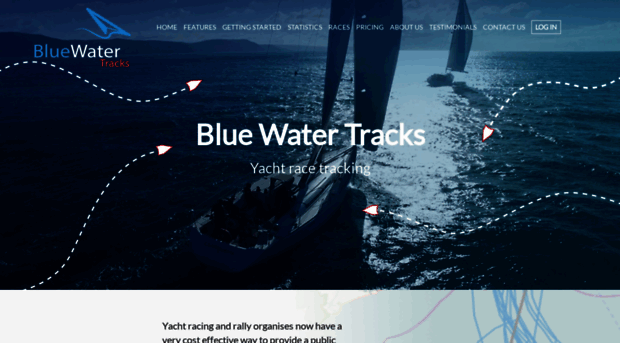
Child safety
Trustworthiness
MALICIOUS CONTENT INDICATORS
Bluewatertracks.com most likely does not offer any malicious content.
Siteadvisor
SAFEBROWSING
Secure connection support
Bluewatertracks.com provides SSL-encrypted connection.
ADULT CONTENT INDICATORS
Bluewatertracks.com most likely does not offer any adult content.
Popular pages
Ocean yacht race and rally satellite tracking with public race map, bio's, boat and crew photos. Perfect for all ocean yacht races and rallies.

Home » Blog » Bluewater sailboats » The best bluewater sailboats (we analyzed 2,000 boats to find out)
The best bluewater sailboats (we analyzed 2,000 boats to find out)
By Author Fiona McGlynn
Posted on Last updated: May 16, 2023
We analyzed two-thousand bluewater sailboats to bring you a list of proven offshore designs
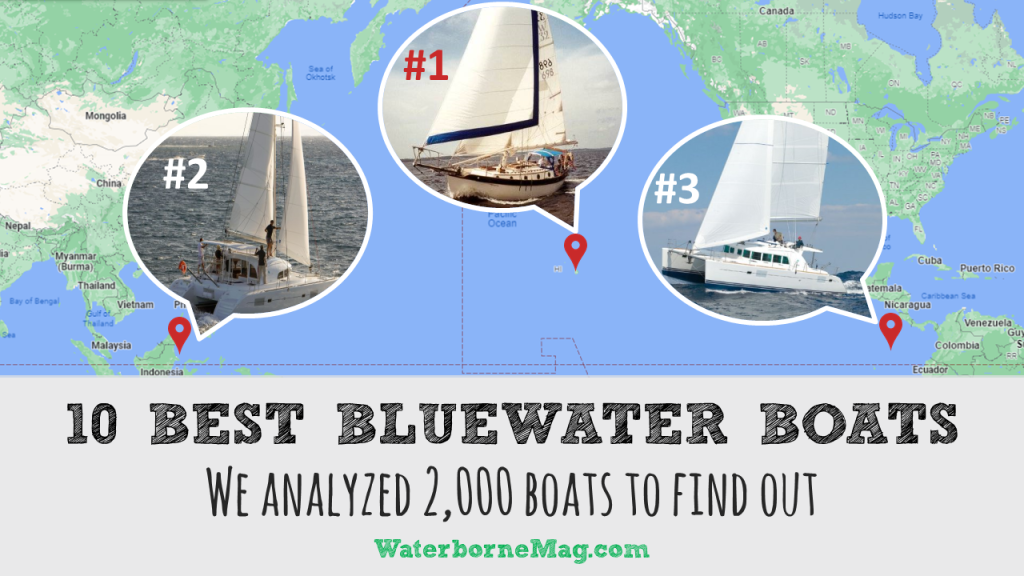
What are the best bluewater sailboats?
This was a question we asked a lot of experienced cruisers when we decided to sail across the Pacific. We needed a boat after all, and we wanted to buy the best bluewater sailboat we could afford.
We heard a lot of strong opinions.
Some sailors thought it was reckless to go offshore in any boat that didn’t have a full keel.
Others prioritized performance, and wouldn’t dream of going anywhere in a slow boat like the Westsail 32 (a.k.a. a “Wet Snail 32”).
Opinions like these left us feeling confused like we had to choose between safety and performance.
If we learned anything from these conversations, it’s that what makes a bluewater boat is a hotly debated topic!
However, there’s a way to cut through all the opinions and get to the bottom of it. The solution is….
We analyzed just under 2,000 boats embarking on ocean crossings (over a 12 year time period) and came up with a list of the ten best bluewater sailboats.
Where did we get our data?
The data for our best bluewater sailboats list comes from 12 years of entries in the Pacific Puddle Jump (PPJ), an annual cross-Pacific rally. We took part in 2017 and had a ball!
You can read about the methodology we used to analyze this data at the bottom of the post.
What do we mean by “best”?
We know, that word is overused on the internet!
Simply, based on our data set, these were the most common makes and models entered in the PPJ cross-Pacific rally. There were at least 10 PPJ rally entries for every make of boat on our top 10 list.
So, these boats are 100% good to go?
No! A bluewater boat isn’t necessarily a seaworthy boat. Almost every cruiser we know made substantial repairs and additions to get their offshore boat ready, adding watermakers , life rafts, solar panels, and more.
Also, you should always have a boat inspected by a professional and accredited marine surveyor before buying it or taking it offshore.
But my bluewater baby boat isn’t on this list!?
There are hundreds of excellent bluewater yachts that are not on this list. For instance, we sailed across the Pacific in a Dufour 35, which didn’t even come close to making our top 10 list.
Choosing the right boat is very much an individual journey.
Where can I find these bluewater boats for sale?
We recognize that a top 10 list won’t get you very far if you’re shopping for a bluewater boat (especially if you’re looking in the used market).
So, to help you find your perfect boat, we’re going to create a big list of bluewater boats that you can use to refine your search on Yachtworld, Craigslist, or any other places to buy a used boat .
Sign up for our newsletter to get our big list of bluewater boats list as soon as it comes out.
We’re also working on a series of posts by size class. For example, if you’re looking for a smaller boat, you can narrow it down to the best bluewater sailboats under 40 feet .
Takeaways from our analysis
There were no big surprises on an individual boat level. All of these makes are considered good cruisers, some of them are even best-selling designs! However, there were a few things that caught our eye.
“Go simple, go small, go now” still holds water
We were thrilled to see the smallest boat in our roundup at the very top of the list! Westsail 32 owners can take pride in their small but mighty yachts (and ignore all those snail-sayers).
While undoubtedly there’s been a trend towards bigger bluewater cruisers in recent years, small cruising sailboats seem to be holding their own. 60% of the monohulls on this list were under 40 feet (if you count the Valiant 40 which sneaks just under at 39.92 feet).
Cat got our tongue
So, we knew catamarans were a thing, but we didn’t fully appreciate HOW popular they’d become!
50% of our top 10 bluewater boat list consists of catamarans—a good fact to toss out the next time you’re trying to garner a happy hour invite on the party boat next door (which will undoubtedly be a catamaran).
Still got it!
We’ve got good news for all you good old boat lovers! 60% of the boats on our list were first built before 2000.
While these older models are less performance-oriented than modern designs, cruisers value these boats for their ability to stand up to rough seas and heavy weather. It just goes to show that solid bones and classic looks never go out of style.
Alright, without further ado, let’s dive into our list of the 10 best bluewater boats!
The 10 best bluewater boats
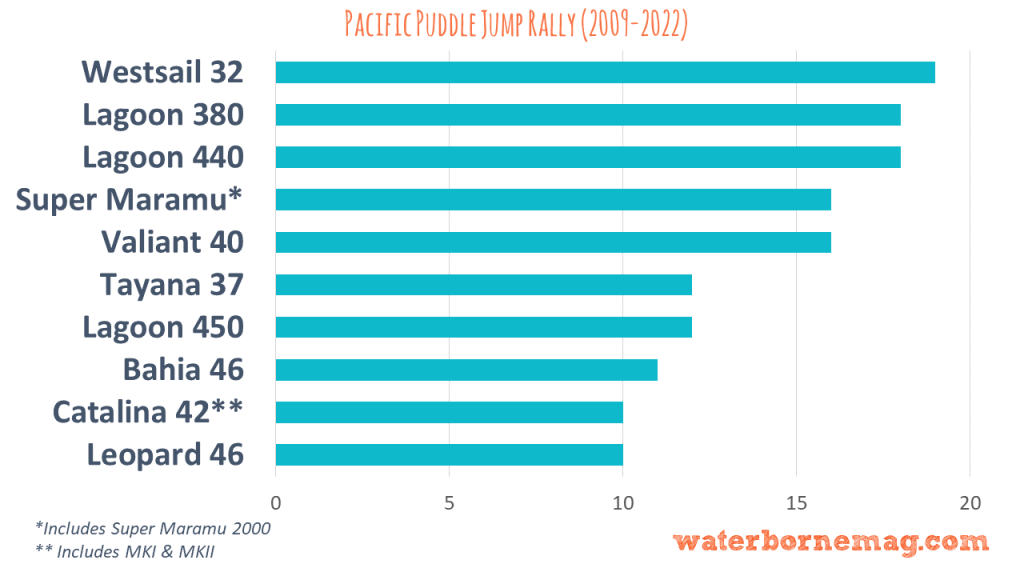
1. Westsail 32
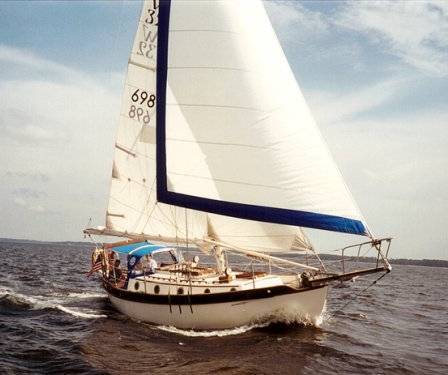
The Westsail 32 is one of the most iconic bluewater cruisers and 19 have set out to cross the Pacific in the PPJ rally since 2009.
In 1973, this small cruising sailboat garnered a 4-page spread in Time magazine. The article inspired many Americans to set sail and the Westsail 32, with its double-ender design, set the standard for what a real bluewater cruiser should look like.
There were approximately 830 built between 1971 and 1980.
This small boat has taken sailors on ocean crossings and circumnavigations. Though considered “slow” by some, the heavily-built Westsail 32 has developed a loyal following for her other excellent offshore cruising characteristics.
If you’re interested in small bluewater sailboats, check out our post on the best small sailboats for sailing around the world .
| LOA | 32.00 ft / 9.75 m |
| First built | 1971 |
| Builder | Westsail (USA) |
| Designer | W. Crealock / W. Atkin |
| Hull type | Long keel, trans. hung rudder |
| Rig type | Cutter |
| Displacement | 19,500 lb / 8,845 kg |
2. Lagoon 380
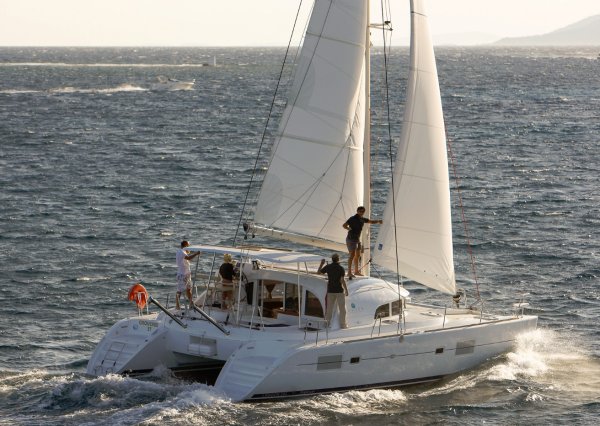
The Lagoon 380 is a reliable, solidly built catamaran and considered roomy for its size. We counted 18 of them in our data set. With over 800 boats built , it may be one of the best-selling catamarans in the world. Like the other boats on this list, the Lagoon 380 has proven itself on long passages and ocean crossings, winning it many loyal fans.
| LOA | 37.89 ft / 11.55 m |
| First built | 2000 |
| Builder | Jeanneau (FRA) |
| Designer | V. Peteghem / L. Prévost |
| type | Cat. twin keel |
| Rig type | Fractional sloop |
| Displacement | 16,005 lb / 7,260 kg |
| More specifications |

3. Lagoon 440
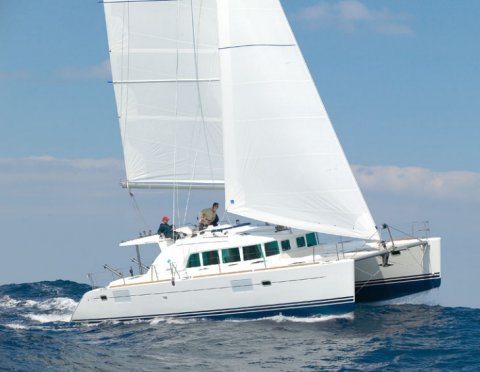
18 Lagoon 440s have set out to cross the Pacific in the PPJ rally since 2009.
Why leave the comforts of home, when you can take them with you? The Lagoon 440 is a luxurious long-range cruiser, offering beautiful wood joinery, spacious accommodations, and a deluxe galley. Oh, and you have the option of an electric boat motor !
SAIL and Sailing Magazine have both done in-depth reviews of the Lagoon 440 if you want to learn more.
| LOA | 44.65 ft / 13.61 m |
| First built | 2004 |
| Builder | Lagoon (FRA) |
| Designer | V. Peteghem / L. Prévost |
| Hull type | Cat. twin keel |
| Rig type | Fractional sloop |
| Displacement | 26,786 lb / 12,150 kg |
4. Amel Super Maramu (incl. SM 2000)
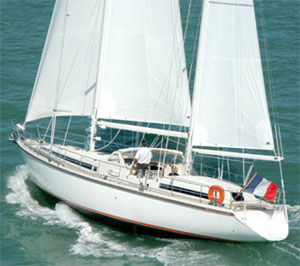
If you follow the adventures of SV Delos on YouTube, you probably know that the star of the show (SV Delos— in case the title didn’t give it away ) is an Amel Super Maramu. These classic bluewater sailboats can be found all over the world, proof they can go the distance.
We counted 16 Amel Super Maramus and Super Maramu 2000s in our list of PPJ entries.
Ready to join the cult of Amel? Read more about the iconic brand in Yachting World.
| LOA | 52.49 ft / 16.00 m |
| First built | 1989 |
| Builder | Amel (FRA) |
| Designer | H. Amel / J. Carteau |
| Hull type | Wing keel |
| Rig type | Masthead ketch |
| Displacement | 35,274 lb / 16,000 kg |
5. Valiant 40
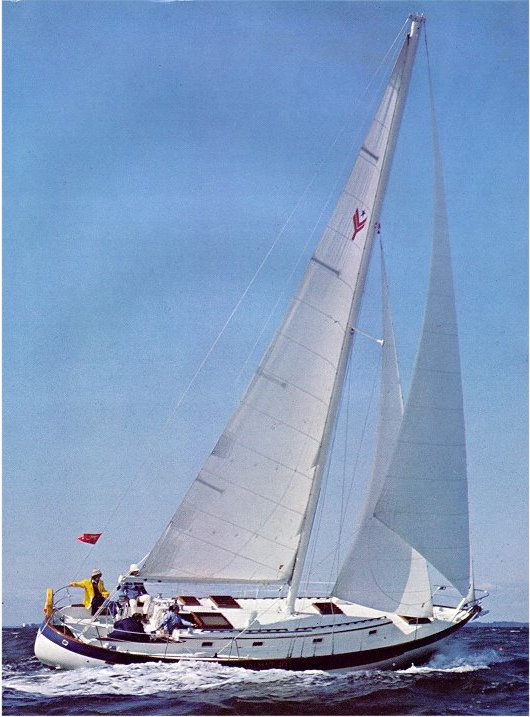
When I interviewed legendary yacht designer, Bob Perry, for Good Old Boat in 2019, he told me that the Valiant 40 was one of the boats that most defined him and marked the real start of his career.
At the time, heavy displacement cruisers were considered sluggish and slow, especially in light winds.
Perry’s innovation with the Valiant 40 was to combine a classic double ender above the waterline, with an IOR racing hull shape below the waterline. The result was the first “performance cruiser”, a blockbuster hit, with over 200 boats built in the 1970s.
It’s no surprise we counted 16 Valiant 40s in our data set.
Cruising World magazine dubbed it “a fast, comfortable, and safe cruising yacht,” and there’s no doubt it’s covered some serious nautical miles.
It’s worth noting that there were blistering problems with hull numbers 120-249 (boats built between 1976 and 1981). Later models did not have this problem. Despite the blistering issues, the Valiant 40 remains one of the most highly thought of bluewater designs.
| LOA | 39.92 ft / 12.17 m |
| First built | 1973 |
| Builder | Uniflite/Valiant (USA) |
| Designer | R. Perry |
| Hull type | Fin keel, rudder on skeg |
| Rig type | Cutter |
| Displacement | 23,520 lb / 10,668 kg |
6. TAYANA 37
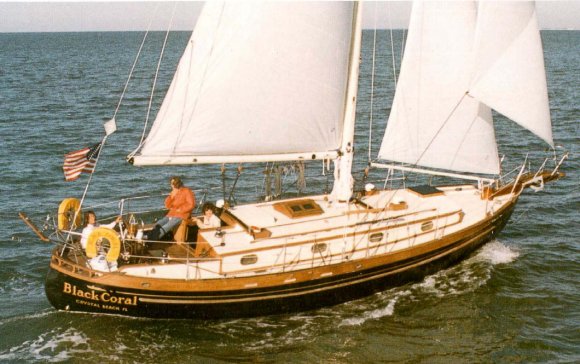
The Tayana 37 is another hugely popular Perry design. The first boat rolled off the production line in 1976 and since then, nearly 600 boats have been built. Beautiful classic lines and a proven track record have won the Tayana 37 a devoted following of offshore enthusiasts.
12 Tayana 37s have set out to cross the Pacific in the PPJ rally since 2009. Read more about the Tayana 37 in this Practical Sailor review .
| LOA | 36.67 ft / 11.18 m |
| First built | 1976 |
| Builder | Ta Yang (TWN) |
| Designer | R. Perry |
| Hull type | Long keel |
| Rig type | Cutter |
| Displacement | 22,500 lb / 10,206 kg |
7. Lagoon 450
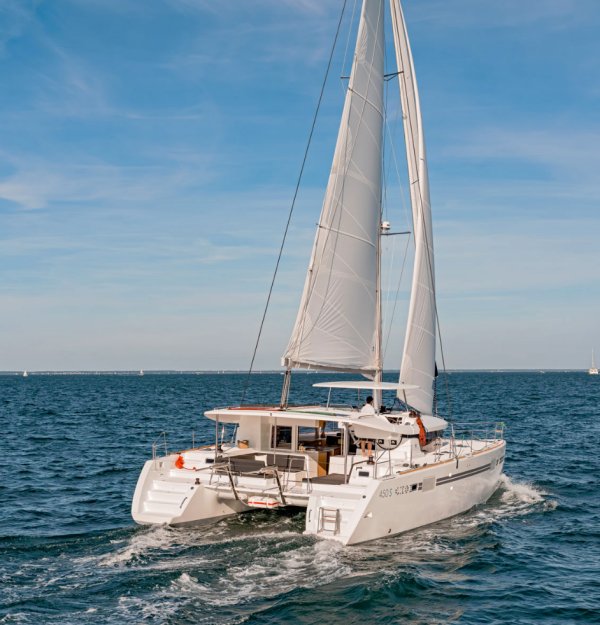
If this list is starting to sound like a paid advertisement, I swear we’re not on Lagoon’s payroll! This is the third Lagoon on our list, but the data doesn’t lie. Lagoon is making some of the best cruising sailboats.
The 450 has been a hot seller for Lagoon, with over 800 built since its launch in 2014. While not a performance cat, the Lagoon 450 travels at a reasonable speed and is brimming with luxury amenities.
At least 12 owners in the PPJ rally chose the Lagoon 450 to take them across the Pacific. It’s no wonder SAIL had so many good things to say about it.
| LOA | 45.80 ft / 13.96 m |
| First built | 2014 |
| Builder | Lagoon (FRA) |
| Designer | V. Peteghem / L. Prévost |
| Hull type | Cat. twin keel |
| Rig type | Fractional sloop |
| Displacement | 33,075 lb / 15,003 kg |
8. Fountaine Pajot Bahia 46
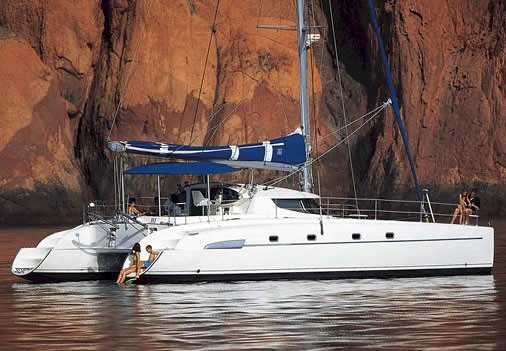
There were 11 Fountaine Pajot Bahia 46s in our data set.
Fountaine Pajot released the Bahia 46 in 1997, a sleek design for traveling long distances. Its generously-sized water and fuel tanks along with ample storage for cruising gear are a real plus for the self-sufficient sailor.
According to Cruising World , “Cruising-cat aficionados should put the Bahia 46 on their “must-see” list.”
| LOA | 46.10 ft / 14.05 m |
| First built | 1997 |
| Builder | Fountaine Pajot (FRA) |
| Designer | Joubert-Nivelt |
| Hull type | Cat. twin keel |
| Rig type | Fractional sloop |
| Displacement | 21,385 lb / 9,700 kg |
| See |
9. Catalina 42 (MKI, MKII)
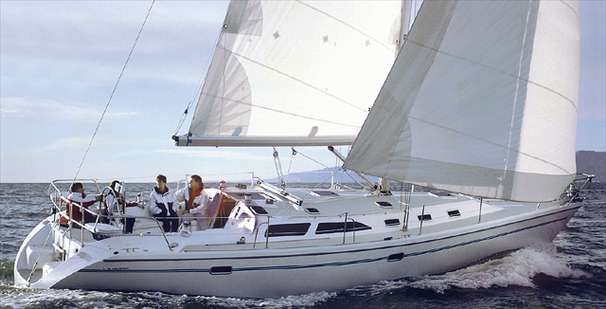
10 Catalina 42s (MKI and MKII) have set out to cross the Pacific in the PPJ rally since 2009.
The Catalina 42 was designed under the guidance of the legendary yacht designer and Catalina’s chief engineer, Gerry Douglas.
One of Catalina’s philosophies is to offer “as much boat for the money as possible,” and the Catalina 42 is no exception. According to Practical Sailor , Catalina aims to price its boats 15% to 20% below major production boats like Hunter and Beneteau.
Practical Sailor has a great in-depth review of the Catalina 42 .
| LOA | 41.86 ft / 12.76 m |
| First built | 1989 |
| Builder | Catalina (USA) |
| Designer | Catalina |
| Hull type | Fin keel, spade rudder |
| Rig type | Masthead sloop |
| Displacement | 20,500 lb / 9,299 kg |
10. Leopard 46
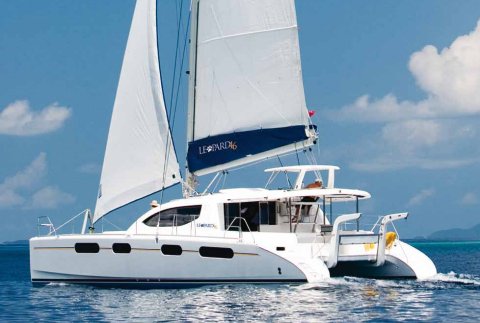
Since 2009, 10 Leopard 46s have embarked on Pacific crossings in the PPJ rally.
Leopards have won legions of fans for their high build quality, robust engineering, and excellent performance.
The Leopard 46 also boasts something of a racing pedigree. It was built in South Africa by Robertson and Caine and designed by Gino Morelli and Pete Melvin, who came up with the record-breaking catamaran Playstation / Cheyenne 125 .
Read more about the Leopard 46 in this Cruising World review .
| LOA | 46.32 ft / 14.12 m |
| First built | 2006 |
| Builder | Robertson & Caine (RSA) |
| Designer | Morelli & Melvin |
| Hull type | Cat. twin keel |
| Rig type | Fractional sloop |
| Displacement | 24,206 lb / 10,980 kg |
Methodology
What the data is and isn’t.
The PPJ data was a real boon because it reflects a wide range of cruising boats: small, big, old, new, expensive, and affordable. We think this may be because the PPJ is a very financially accessible rally—the standard entry cost is $125 or $100 if you’re under 35 (age or boat length!).
We did look at data from other (pricier) rallies but found that the results skewed towards more expensive boats.
Needless to say, the data we used is just a sample of the bluewater boats that crossed the Pacific over the last 10+ years. Many cruisers cross oceans without participating in a rally!
Entries vs. completions
The data we used is a list of the PPJ entries, not necessarily the boats that completed the rally. In instances where we saw the same boat entered multiple years in a row, we assumed they’d postponed their crossing and deleted all but the latest entry to avoid double counting.
Boat make variations
The world of boat building and naming can get pretty complicated. Sometimes a manufacturer changes a boat’s name a year or two into production, other times the name remains the same but the boat undergoes a dramatic update.
For the most part, we’ve used SailboatData.com’s classification system (if they list the boats separately, then we have also), except where there are two separately listed models that have the same LOA, beam, and displacement.
Fiona McGlynn is an award-winning boating writer who created Waterborne as a place to learn about living aboard and traveling the world by sailboat. She has written for boating magazines including BoatUS, SAIL, Cruising World, and Good Old Boat. She’s also a contributing editor at Good Old Boat and BoatUS Magazine. In 2017, Fiona and her husband completed a 3-year, 13,000-mile voyage from Vancouver to Mexico to Australia on their 35-foot sailboat.
Terms and Conditions - Privacy Policy
Better Sailing

What Makes a Good Blue Water Cruising Sailboat
Before we get started, to analyze the features that make a good sailboat, I’d like to have you all take a seat please— and stop sharpening those knives! That includes you, sir, with the calloused hands and wood shavings in your beard!
For some reason, boat talk can bring out the ogre in some people, which is too bad. One of the great things about sailing is the incredible diversity of sailboats to do it in: big sailboats, little sailboats, wide sailboats, skinny sailboats, monohulls, multihulls, wood sailboats, fiberglass sailboats, steel sailboats, aluminum sailboats—even sailboats made of cement! The number of sailboat types that continue to be built and sailed, even today, is truly incredible.
My own “breakthrough” in appreciating boat diversity came a few years ago on a bareboat charter cruise on Lake Erie with my wife. As I’ve intimated elsewhere, there was a time when I wanted nothing to do with any boat that wasn’t either a racer or an old classic with heartbreaking overhangs. Then along came this charter aboard a 34-footer of the type I had always dismissed as being the epitome of a soulless “plastic” cruiser.
In fact, I had barely set foot aboard that little trim vessel before I realized how wrong and even downright ignorant I’d been. The marina was as crowded as a shopping mall on the day after Thanksgiving, but we backed that handy little sloop out of her slip and turned toward the channel pretty as you please. A couple of hours later, a line of thunderheads rumbled in from the northwest, and we had to reef down for a bit of a squall, but again, there was no problem—despite some hail and about 35 knots of wind.
That night we relaxed in the comfortable cockpit, slowly working our way through a bottle of wine. Then we went below for a good night’s rest in the boat’s spacious aft stateroom. The next morning we awoke refreshed, had breakfast, and then headed back out onto the lake, ready and eager to do it all over again. In short, we had an absolutely fantastic time, and the boat performed splendidly in every way. It really was a revelation, both the quality of the boat and the realization of my own pig-headedness.
This is not to say that all boats are good for all purposes. Deepwater cruisers need to meet certain criteria that make them markedly different from top-flight racers. The same goes for daysailers and coastal cruisers. The point is, each design has to be judged on its merits and in the context of the boat’s intended purpose. Assuming the builder has successfully executed the design, whether or not the boat is a good one ultimately depends on the sailor.
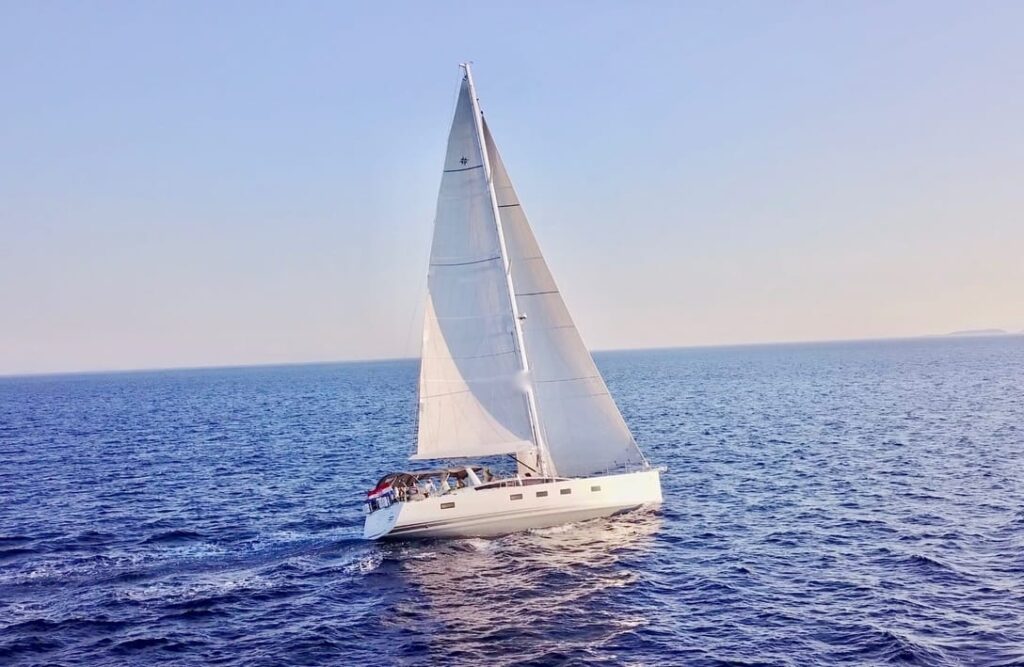
>>Also Read: Sailing Pre-Departure Checklist
What Makes a Good Blue Water Sailboat?
When it comes to crossing oceans with a sailboat, you obviously need a sturdy, reliable boat in the event you meet serious winds. The ideal bluewater cruiser, however, can’t be simply a waterborne tank—otherwise, it will take forever and a day to get anywhere, and you’ll be sitting duck for any storm heading your direction. In addition, the ideal cruising boat needs to take care of its crew on days when it isn’t blowing stink—days that far outnumber the stormy ones. It also needs to provide a comfortable place to rest and relax at the end of a day’s sail—not a trivial consideration, as even the most dedicated cruiser spends substantially more time at anchor or tied to the dock than out on the briny. Even an aggressive circumnavigation schedule will generally allow the crew two days in port for every day of sailing.
Finally, a bluewater cruiser needs to be both seaworthy and sea-kindly in its design and construction—that is, it must be able to both stand up to the rigors of heavy weather and spare the crew undue fatigue in the course of a typical passage. This is a boat that sails well but doesn’t require tremendous effort to keep it in trim. It’s a boat that tracks well—i.e., it’s steady on its helm—and has easy motion, so the crew doesn’t get banged up every time the weather starts kicking up some waves.
Here Is A Short List of Characteristics That Make a Good Offshore Sailboat
Structure and equipment installation.
To be truly seaworthy, a boat must be structurally sound and its equipment correctly installed. The hull-to-deck joint must be well made, and all bulkheads and other interior structural elements should be securely bonded to the underside of the deck and inside of the hull. Equally important, items like hatches, rudder bearings, and steering gear need to be robustly constructed and robustly installed, so they can withstand the force of a crashing sea.
On deck, a deepwater cruiser should have tall stanchions set in sturdy bases. It will often have bulwarks—or at the very least, toerails—to brace your feet against if you ever find yourself sliding down the deck when the boat is on its ear. There should be plenty of sturdy handrails along the cabintop so that you never have to make any kind of “leap of faith,” lunging from one handhold to the next when moving forward to the mast or foredeck. There should also be adequate side deck space between the cabin trunk and the bulwarks or toerail so that going forward isn’t a struggle. And, of course, the side decks and foredeck should be surfaced with aggressive nonskid. Beware of stylishly molded cabin trunks—their gracefully curved surfaces can be treacherous in rough weather.

>>Also Read: Cruising Sailboats – Parts and Features
Hull Design
The hull of a good cruising sailboat should have relatively low freeboard (distance from the waterline to the upper edge of the deck) to minimize the impact of windage in extreme weather. It should also have a moderate beam, a bit of forefoot beneath the waterline, and a full keel or a moderately proportioned fin keel to help with heaving. The cockpit should be large enough to be comfortable in normal conditions but not overly large. If you’re ever pooped, a too-large cockpit will hold that much more water, the weight of which can depress your stern and make you vulnerable to being pooped again.
All deepwater boats should have a bridgedeck “step” of sorts between the front of the cockpit and the companionway leading below, so water from a flooded cockpit won’t slop into the cabin. The cockpit should also be equipped with large drains to allow water that comes aboard to leave as quickly as possible.
Finally, a blue water cruiser must have a safe limit of positive stability (LPS)—at least 120 degrees, although higher is better—to prevent it from capsizing in heavy seas. LPS is the heel angle at which the hull and keel stop resisting the capsizing forces of the wind and waves and actually abet them until the boat is completely inverted. In addition, the LPS dictates how stable a boat will be when it’s upside down—in other words, how easily the boat will re-right itself. As Calder explains, a sailboat with an LPS of 100 degrees will, in theory, remain inverted for about 5 minutes before it’s righted again by wave action.
A sailboat with an LPS of 120, on the other hand, should right itself in about 2 minutes. A sailboat with an LPS of 140 will theoretically pop right back up almost as soon as it goes over. Think about how long you can hold your breath—and about how long your hatches, hatchboards, vents, and portlights will hold when the boat is upside down in surging conditions. A couple of minutes could make all the difference in the world. For the record, many sailors believe that an LPS of 115 degrees is acceptable on an offshore boat.
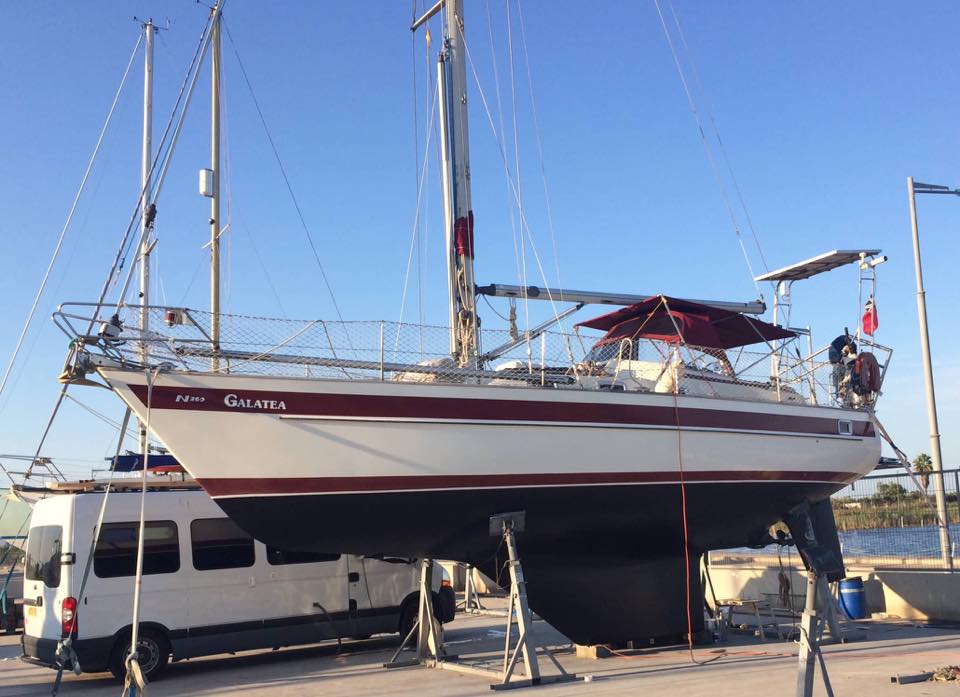
>>Also Read: Full Vs Fin Keel On Sailboats
Comfort and Ease of Sailing
Many of the features that make for a seaworthy boat also make for a seakindly one. A sailboat with a moderate length-to-beam ratio, a bit of forefoot, and a full keel or moderately proportioned fi n, for example, not only heaves-to well but also tends to track better. Granted, the boat might not be the fastest thing on the water, but what cruising sailor wants to continually tweak and trim to eke out that last fraction of a knot of boat speed anyway? Likewise, a solid masthead rig with a moderate sail area will get you where you want to go without springing any nasty little surprises.
In Nigel Calder’s (sailing writer) words, “On a cruising boat, it is a fundamental mistake to gear the concept of fast passage making to maximizing the absolute speed potential of a boat at the expense of ease of handling, comfortable motion, stability, security, and other highly desirable attributes. Exhilarating performance can be fun in the short term but extremely fatiguing in the long term. Instead, the goal should be to achieve good sustained performance in all kinds of conditions in an environment that is as relaxing and as much fun as it can be.”
A deepwater boat should have V-shaped sections in the bow that will allow the hull to slice through the waves on a beat or close reach, instead of slapping and pounding. It should also be stiff enough to carry sail, but not so stiff that it has a “snappy” motion when coming off a swell—which calls for a moderate L/B to ensure adequate but not too much form stability. In this same vein, a boat with a moderate to heavy displacement-to-length ratio—unlike a featherweight speedster—tends to pass smoothly through the waves instead of bouncing over them or simply bobbing on top of them like an oversized cork.

>>Also Read: Must-Have Boat Safety Equipment For Sailing
Accommodations
The list in this category is pretty exhaustive. An ocean is a big place, but for the crew of a sailboat on passage, it’s essentially no bigger than the boat’s LOA (Length Overall). Nonetheless, the shortlist includes adequate sea berths, a galley that can be safely used in a seaway, plenty of storage, and a cockpit that’s comfortable and safe for watchkeeping.
When it comes to sea berths, simpler is better. Each berth needs to be a little more than 6 feet long and located no farther forward than around amidships. The motion in a forepeak berth in any kind of seaway will make sleeping impossible. Berths should also be parallel with the boat’s centerline, not angled dramatically inward. Otherwise, either your head or feet will be higher whenever the boat heels while you’re trying to sleep. Finally, sea berths should be straight to avoid cramped shoulders or feet. This consideration may seem obvious, but many modern cruising boats are equipped with curved or angled settees—those seats in the saloon that double as sea berths underway— which look great at boat shows but can be absolutely miserable for sleeping.
In the galley, you need a cooking area that not only includes the necessary equipment for preparing meals—stove, microwave, oven, cutting board, and the like—but a layout that will make cooking safe and as easy as possible when the boat is sailing on its ear. The key is a wraparound layout, in which the counters form a U or G shape, so you can brace yourself against an opposing counter or in a corner and free your hands for cooking.
Sinks should be deep and as close to the centerline as possible, where the motion is less severe. Fiddles—the little walls or barriers surrounding the countertops to stop things from sliding off —need to be tall and perpendicular, not low and artistically rounded. The galley should be located as close to the companionway as possible for ventilation and ease of passing snacks or coffee to crewmembers on deck. A location near the companionway also puts the galley well aft, where hull motion is easier.

>>Also Read: What To Wear When Sailing
You can never have too much storage. Extended cruising requires a tremendous amount of storage space—for everything from charts to food to spare engine parts and toothpaste—and unless your boat is 50 feet or longer, there’s barely enough room for everything. Not only that, storage space can be surprisingly scarce even in larger cruisers, as designers struggle to shoehorn in more and more accommodations per foot of LOA. The double-size quarter berths tucked under the cockpits of many newer boats may look great. Still, the only way to fit them in is to eliminate a voluminous amount of storage that is otherwise available under the cockpit seats.
Large staterooms in the bow take away hull volume that could otherwise house wet lockers for storing damp foul-weather gear, and “sugar scoop” transoms with those oh-so-convenient swim steps leave no room for lazarettes—those wonderfully spacious lockers located aft of the cockpit. Next time you’re at a boat show, do a quick inventory of that 45-foot beauty with the multiple heads and staterooms. See what’s behind some of those lovely cherry-finished doors, and tally up the total storage area—including those “cabinets” that are so tiny they’re essentially useless. You may be surprised that a “big” boat can actually have remarkably little room for putting things away.
The cockpit should be the right size to “enclose” the on-watch crew—usually one person unless the boat and crew are very large—so they don’t have to worry about being washed around in heavy weather conditions. A cockpit’s width and length are key; there are few things in this life more reassuring than tucking yourself in where the cockpit seat meets the cabin trunk and having your feet braced against the cockpit seat or seat back to leeward— an unrealized comfort if the cockpit is too wide. In addition, all the necessary control lines should be close at hand. The helmsman shouldn’t have to let go of the wheel or tiller when trimming either the main or the jib sheets. The cockpit should also have several strong points where you can secure a safety harness and easy access to jacklines without having to expose yourself to the waves.
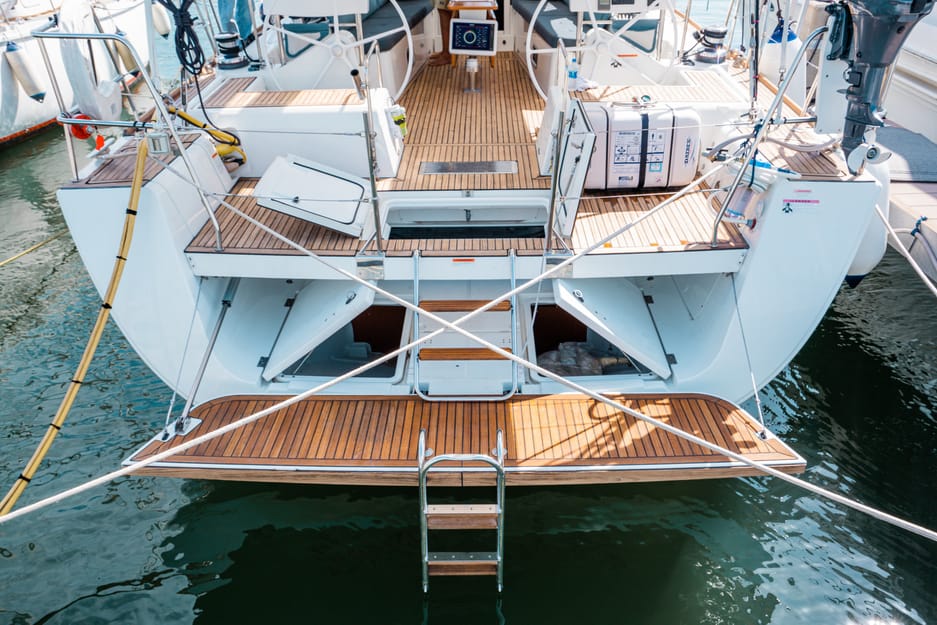
What Makes a Good Offshore Blue Water Sailboat? – Summary
To reiterate, these are just a few features of a good cruising sailboat—albeit critical ones. The real key that makes a good offshore sailboat is to find one that’s functional and moderate in the areas of sailing and accommodations; fast but not too fast; roomy but not too roomy; and in which everything has a purpose. After all, crossing an ocean in a tiny sailboat is serious business—tremendously satisfying, but serious nonetheless.
Peter is the editor of Better Sailing. He has sailed for countless hours and has maintained his own boats and sailboats for years. After years of trial and error, he decided to start this website to share the knowledge.
Related Posts

Atlantic vs Pacific: Which is More Dangerous for Sailing?

Why Do Sailboats Lean?

How Does a Boat Sail Upwind? Unveiling the Mechanics of Against the Wind Sailing

How Does Sailing Work? The Physics of Sailing
- Buyer's Guide
- Destinations
- Maintenance
- Sailing Info
Hit enter to search or ESC to close.

- OUR TRAWLER YACHTS
- – KROGEN 44 AE
- – KROGEN 48 AE
- – KROGEN 50 Open
- – KROGEN 52
- – KROGEN 58 EB
- – KROGEN 60 OPEN
- – KROGEN 70
- OUR PERFORMANCE YACHTS
- – SUMMIT MOTORYACHTS
- PRE-OWNED YACHTS
- Full Displacement Trawler Explained
Kadey-Krogen Hull Design
- Bluewater Cruising
- Engines and Systems
- Construction
- Living On Our Trawlers
- Accommodations
- The Kadey-Krogen Team
- Trawler Living
- Atlantic Crossings
- Inside Passage
- Owner Groups and Blogs
- Latest News and Updates
- Waypoints Magazine
PASSAGEMAKING
Perfecting the long-distance trawler yacht since 1977, why a kadey-krogen built trawler is the best bluewater yacht.
At Kadey-Krogen Yachts we’ve focused on one thing for more than 45 years, and we believe we do that very well: We design and build bluewater yachts designed to take their owners on an adventure of a lifetime. And that’s it. When a builder has such a dedicated focus and does not waste time, effort and resources chasing often fleeting trends, they get exceptionally good at doing that one thing.
Kadey-Krogen pioneered the long-distance trawler in 1977 with the introduction of the venerable 42 and every boat launched since then represents a culmination of expertise and a perpetual quest for perfection for our singular objective. We also concentrate these efforts on the owner operator market where a cruising couple or family can safely and easily operate a Krogen. This is why we focus on the 44- to 70-foot range. Could we build a 100-footer? Sure we could. However, there are exponentially more elements in the 80-foot plus range that we believe distract from the focus of building the best bluewater trawler yacht in our niche. Some builders rationalize their focus on building a wide array of models in the larger size range by stating that the lessons learned on building bigger models will trickle down the line to other models. We respectfully disagree with this premise. Each and every Krogen model from 44 to 70 feet is designed to efficiently go through the water in all conditions and keep the owners safe and comfortable whether on a passage or on the hook, regardless of the LOA. Discover here how we’ve accomplished these goals since 1977 and learn to how you too can enjoy your time on the water.

The Full Displacement Trawler Explained

How-To: Maintenance
7 Legendary Solo Bluewater Sailboats Worth Considering
When setting out to explore the open seas solo, you'll have to choose the right bluewater sailboat from so very many available options. The perfect boat for sailing single-handed is one that's not only safe and seaworthy, but also easy to handle on your own. In this article, we've handpicked the top 7 legendary solo bluewater sailboats worth considering for their excellent track records.
The most legendary solo bluewater sailboats are the Contessa 32, Westsail 32, Hallberg-Rassy 42F, Pacific Seacraft 37, Island Packet 38, Tayana 42, and Amel 54. These boats have it all: from robust designs to a world-renowned reputation for performance and reliability. They are known for their seaworthiness, durability, and comfort.
We understand the importance of balancing comfort and performance when spending prolonged periods at sea. Each of these sailboats has been proven to provide a harmonious blend of these attributes. Let's get to know them more below.
- Solo bluewater sailboats are designed to be sailed by a single person, making them ideal for solo circumnavigation or long-distance cruising.
- You can get the Contessa 32 and Westsail 32 for as little as $30,000.
- The maintenance and repair costs of the seven boats range from $5,000 to $50,000 per year.
- Marina fees and insurance can range from $5,000 to $20,000 per year.
- Factor in upgrades and equipment costs that can reach up to $100,000.
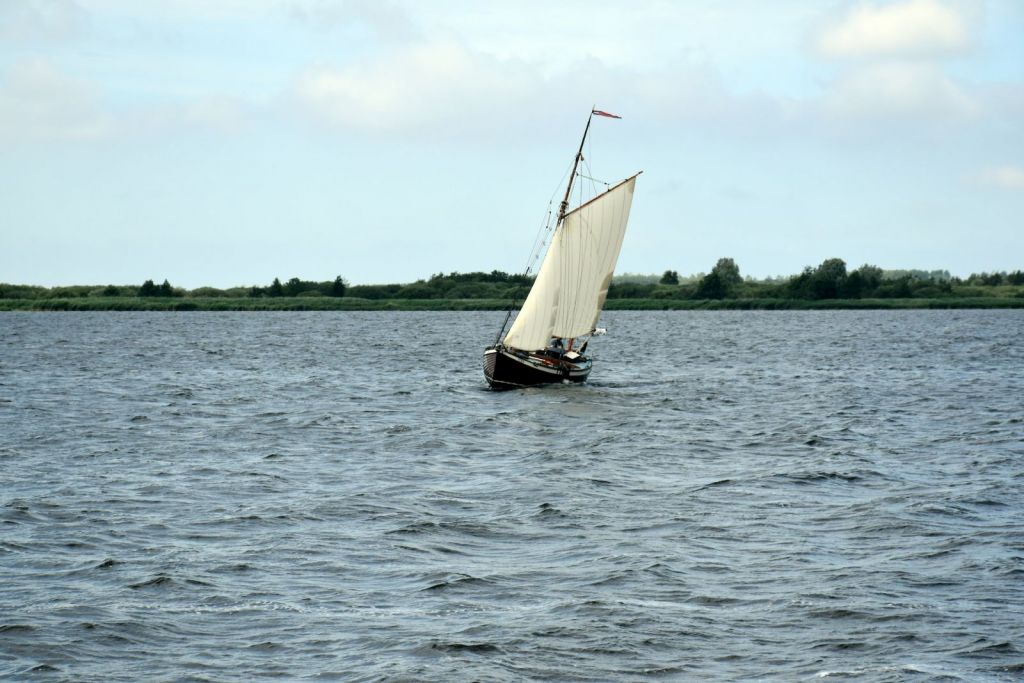
On this page:
The best solo bluewater sailboats, what makes a good solo bluewater sailboat, cost considerations when choosing a sailboat, maintaining your bluewater sailboat.
| Initial Purchase Price | Maintenance and Repairs | Marina Fees and Insurance | Upgrades and Equipment | |
|---|---|---|---|---|
| $30,000 to $60,000 | $5,000 to $10,000 per year | $5,000 per year | $5,000 to $15,000 | |
| $30,000 to $80,000 | $5,000 to $10,000 per year | $5,000 per year | $5,000 to $20,000 | |
| $200,000 to $400,000 | $10,000 to $20,000 per year | $10,000 per year | $20,000 to $50,000 | |
| $100,000 to $200,000 | $10,000 to $20,000 per year | $10,000 per year | $20,000 to $40,000 | |
| $100,000 to $200,000 | $10,000 to $20,000 per year | $10,000 per year | $20,000 to $40,000 | |
| $100,000 to $250,000 | $10,000 to $20,000 per year | $10,000 per year | $20,000 to $50,000 | |
| $500,000 to $1,000,000 | $20,000 to $50,000 per year | $20,000 per year | $50,000 to $100,000 |
Contessa 32 is a classic, compact, and seaworthy sailboat
Contessa 32's sturdy construction and excellent sailing performance have earned it a legendary reputation among sailors. With a well-designed interior layout, it has space for living aboard during your solo adventures. The Contessa 32 is a classic bluewater sailboat designed by David Sadler in the 1970s. It is known for its excellent balance, seaworthiness, and speed. It has a full keel, moderate displacement, and a classic design that has stood the test of time.
Westsail 32 is known for its rugged construction
The Westsail 32 gained fame as an affordable, rugged, and capable long-distance cruiser. Its full keel and sturdy hull ensure a comfortable ride in rough seas. The practical, function-driven interior makes it easy for solo sailors to maintain and navigate the vessel while providing essential amenities for an extended voyage.
Westsail 32 is another classic bluewater sailboat that was designed by William Crealock in the 1970s. It is known for its rugged construction, spacious interior, and excellent performance in heavy weather. The Westsail 32 has a full keel, heavy displacement, and a classic double-ender design.
Hallberg-Rassy 42F is known for its top-notch craftsmanship
The Hallberg-Rassy 42F is another superb choice for single-handed bluewater sailing. This Swedish-built yacht is well-renowned for its top-notch craftsmanship, stability, and comfort. It offers a spacious, well-lit interior, ensuring you'll enjoy your time below deck while cruising the open seas.
Hallberg-Rassy 42F is a modern bluewater sailboat designed by German Frers in the 1990s. It is known for its luxurious interior, excellent performance, and high-quality construction. The Hallberg-Rassy 42F has a fin keel, a spade rudder, and a modern design that combines comfort and performance.
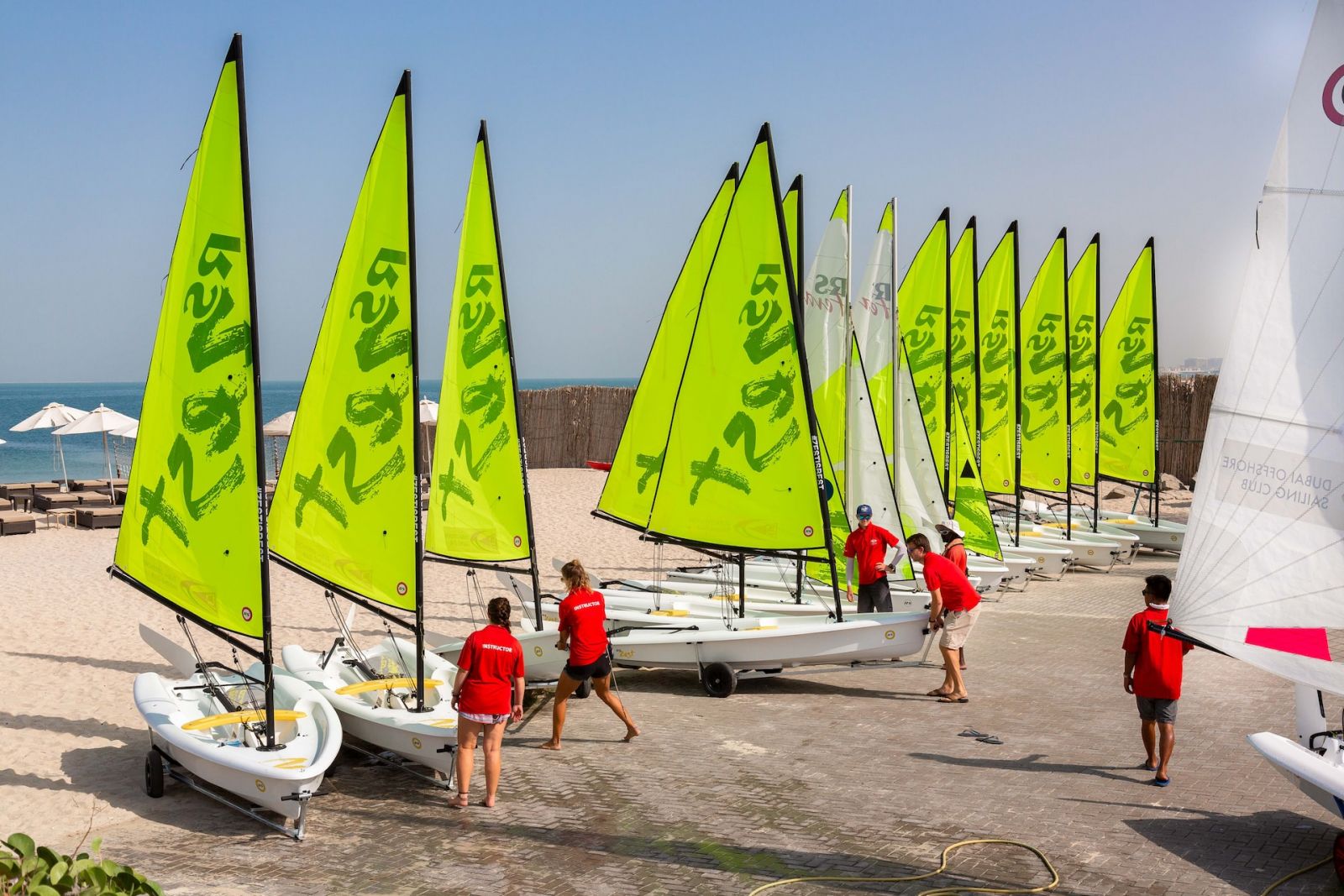
Pacific Seacraft 37 is designed for serious cruising
Pacific Seacraft 37 is a sturdy and reliable boat for solo sailors. Its moderate displacement and full keel provide excellent stability, while the well-thought-out interior layout includes abundant storage and comfortable living quarters. Its reputation as a proven bluewater cruiser makes it a top choice for solo sailors. The Pacific Seacraft 37 is another classic bluewater sailboat designed by Bill Crealock in the 1970s. It is known for its excellent balance, seaworthiness, and comfort.
Island Packet 38 is known for its spacious interior
Island Packet 38 is a popular choice among solo cruisers, thanks to its stable full keel design and living space. Its build quality, comfort, and performance make it well-suited for long-distance sailing. The spacious interior and practical layout ensure you have everything needed for a successful solo journey. Island Packet 38 is a modern bluewater sailboat designed by Bob Johnson in the 1990s. It 38 has a full keel, moderate displacement, and a modern design that combines comfort and performance.
Aside from bluewater sailing , there are other types of sailing discussed in this article.
Tayana 42 is known for its excellent balance, seaworthiness, and comfort
Tayana 42 is a comfortable, sea-kindly sailboat, ideal for single-handed offshore cruising. Its balanced performance, easy handling, and well-equipped interior ensure a safe and comfortable journey. It is well-regarded among sailors for its proven bluewater capabilities and timeless styling. The Tayana 42 is another classic bluewater sailboat designed by Bob Perry in the 1970s. It has a full keel, heavy displacement, and a classic design that has stood the test of time.
The Amel 54 is known for its luxury and exceptional build quality
This French-built vessel offers a spacious and comfortable interior with top-of-the-line amenities, making it an excellent option for solo sailors seeking a bluewater cruiser to explore the world in style and comfort. Its easy-to-handle design with advanced sailing systems allows you to sail solo with confidence and ease. The system includes electric winches, furling sails, and a self-tacking jib, which make it easy to handle the boat in all conditions.
To learn more about bluewater sailing , here's our comprehensive article on it.
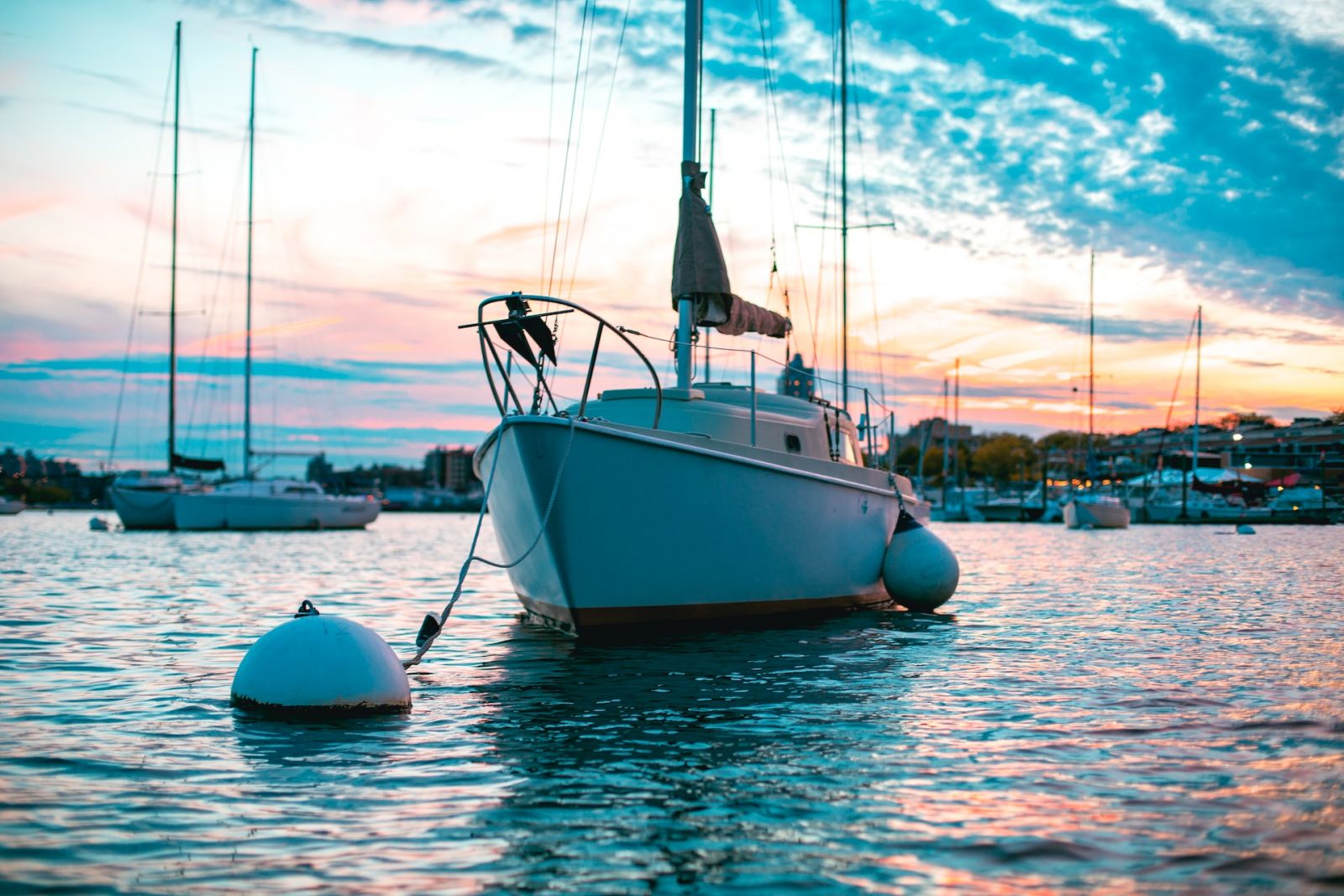
These factors will ensure not only your safety but also your comfort and ease during your sailing adventure.
Size and stability of a solo sailboat
A boat with a wide beam and short waterline provides more stability, making it easier for you to handle the vessel on your own. Some popular sailboat models known for their size and stability include the Westsail 32 and the Hunter Channel 31.
A good solo bluewater sailboat should be large enough to provide adequate storage space for supplies and equipment, while also being stable enough to handle rough seas and high winds. It should also have a well-designed hull shape that provides good stability and balance, and a keel that provides good tracking and prevents the boat from capsizing.
Ease of use and maneuverability of any solo sailboat
Features like roller furling and an electric windlass can make handling the sails and anchor much more straightforward. Also, hydraulic bow/stern thrusters with remotes can help you maneuver your boat easily and safely. Make sure to look for these features when choosing your bluewater sailboat.
A good solo bluewater sailboat should be easy to handle and operate by a single person. It should have a sail plan that is easy to adjust and control, and a steering system that is responsive and easy to use. It should also have a well-designed cockpit that provides good visibility and protection from the elements.
Durability and seaworthiness for long-term safety
A well-built sailboat with a history of proven offshore performance should be at the top of your list. Some of the best and most famous bluewater sailboats include the Alberg 30 and Hanse 371.
A good solo bluewater sailboat should be built to withstand the rigors of extended ocean voyages. It should have a strong, well-built hull that is capable of withstanding heavy seas and high winds. It should also have a well-designed rigging system that is strong and durable, and a keel that is designed to provide good stability and balance.
To learn more about the best keel design for bluewater sailing , here's our article on it.
Comfort and livability of a solo sailboat
Consider the layout and features of the boat, ensuring that it has a comfortable sleeping area, a well-equipped galley, and ample storage space. A good example is the Valiant 40, known for its excellent layout and seaworthiness.
A good solo bluewater sailboat should be comfortable and livable for extended periods of time. It should have a well-designed interior that provides adequate storage space, comfortable sleeping quarters, and a functional galley and head. It should also have good ventilation and lighting, and be well-insulated to provide protection from the elements.
Affordability and availability determine the sailboat's practicality
Set a budget and research suitable sailboats within that price range. Some budget-friendly options include the J/109 and Westsail 32. A good solo bluewater sailboat should be reasonably priced and readily available. It should be affordable for most sailors who are interested in long-distance cruising, and should be available for purchase or charter in most parts of the world.
If you're looking for bluewater sailboats under 40 feet , here's our article where we picked the top 13 most famous ones.
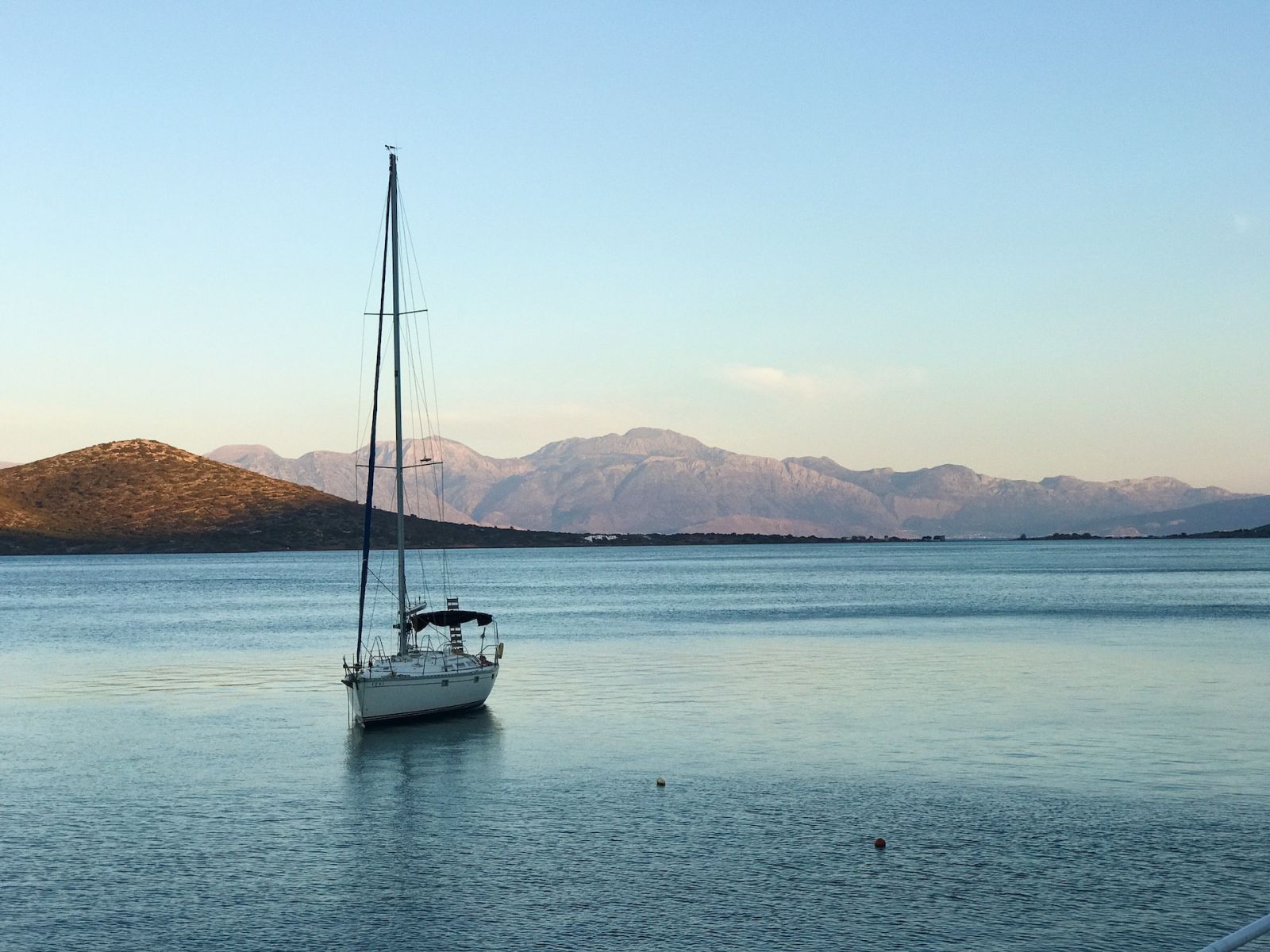
You'll be faced with a range of solo bluewater sailboat options, from budget-friendly to luxury models. Let's explore some factors you should keep in mind to make the best decision for your needs and budget.
Initial purchase price : This is often the first thing people think of when it comes to the cost of a sailboat. There's a wide range in prices, depending on factors like age, size, and brand. For example, a used Alberg 30 might cost between $10,000 and $15,000, while a new Amel 54 could be in the range of hundreds of thousands of dollars. It's important to find a balance between quality and affordability that suits your needs and financial capabilities.
Maintenance and repairs : Owning a sailboat comes with ongoing expenses to keep it in good sailing condition. Regular maintenance tasks like painting, replacing worn rigging, and inspecting safety equipment can add up over time. Be prepared to allocate a portion of your budget for these essential tasks, as neglecting them could lead to more expensive repairs down the line.
Marina fees and insurance : Depending on where you plan to keep your boat, you may incur costs for marina or dockage fees. Additionally, securing insurance coverage for your sailboat is a must to protect your investment. Both of these costs can vary widely, so make sure you factor them into your overall budget.
Upgrades and equipment : To ensure your sailboat is well-suited for solo bluewater sailing, you might need to invest in upgrades to improve its safety and performance. For instance, you may want to add a roller furling system, wind vane, or more advanced navigation equipment. These enhancements can amount to a significant investment, so it's wise to plan financially for any desired upgrades.
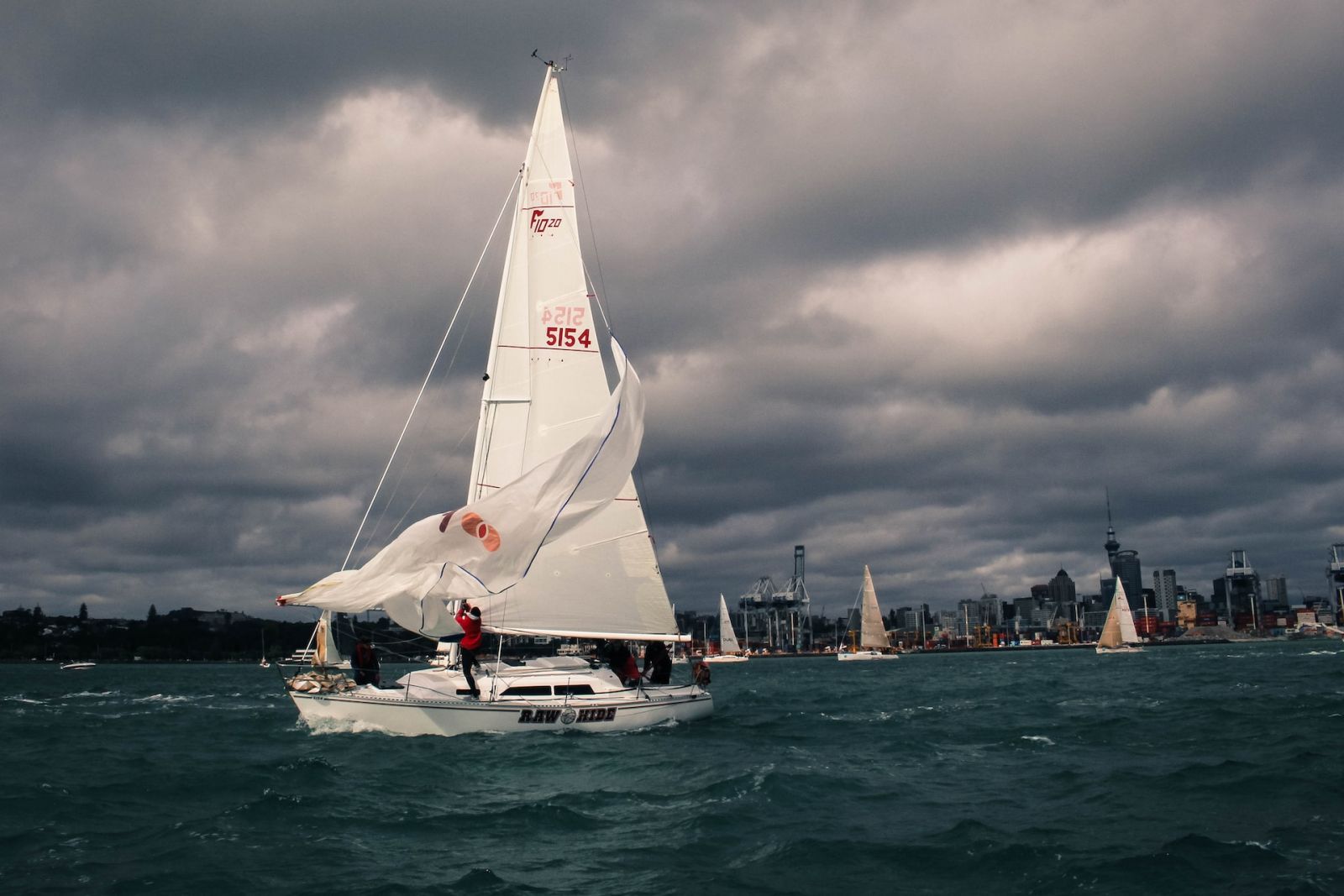
Here are some essential tips to keep your boat in top shape, and ensure its long life and performance during solo journeys:
Regular inspections : Make it a habit to perform a thorough inspection of your sailboat periodically. Examine the rigging, sails, hull, and all mechanical components. Routine inspections allow you to detect any signs of wear, damage or potential problems before they escalate.
Cleaning : Keep your sailboat clean by washing it regularly with freshwater and appropriate cleaning solutions. This simple practice prevents the buildup of dirt, salt, and other debris, which can cause corrosion and damage to your vessel over time.
Checking the bilge : Ensure that your bilge pump is working efficiently and that there's no water accumulating in the bilge area. If there are any signs of water accumulation, investigate the source and address any leaks or issues promptly.
Servicing the winches : Winches play a crucial role in your sailboat’s performance, so it’s essential to inspect, clean, and grease them regularly. This practice will guarantee their smooth operation and prolong their lifespan.
Sail care : Inspect your sails frequently for any tears, wear, or damage. Repair or replace them as necessary. To protect your sails from the sun’s harmful UV rays, always use a sail cover when not in use.
Keeping records : Maintain a logbook to document all maintenance tasks, inspections, and repairs. Not only will this help you keep track of what has been done, but it will also provide valuable information if you decide to sell your sailboat in the future.
Leave a comment
You may also like, what is bluewater sailing.
It's easy to confuse offshore sailing with bluewater sailing - and it's no wonder. Many people do, including myself. So I've decided to list the difference once and …
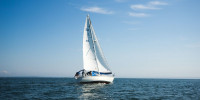
13 World-Famous Bluewater Sailboats Under 40 Feet

What's the Best Keel Design for Bluewater Sailing?

Different Types of Sailing and Racing Explained

41 Sailboat Cruising Essentials for Long Trips
Select your language
Contact Blue Water
Find your nearest Blue Water office. We are located in more than 30 countries worldwide with above 80 offices. Each office work with local knowledge through a global network, and we are always ready to help you with an individual transport and logistics solution
- Middle East
- North America
- South America
Netherlands
Papua new guinea, united kingdom.
- Brisbane [email protected] +61 07 3106 9980 Read more about Brisbane office
- Port of Brisbane [email protected] +61 483 224 915 Read more about Port of Brisbane office
- Darwin [email protected] +61 418 259 144 Read more about Darwin office
- Melbourne [email protected] +61 416 258 107 Read more about Melbourne office
- Perth [email protected] +61 409 165 444 Read more about Perth office
- Sydney [email protected] +61 028 387 4489 Read more about Sydney office
- Baku [email protected] +994 124 644 230 Read more about Baku office
- Rio de Janeiro [email protected] +55 21 2145.0000 Read more about Rio de Janeiro office
- São Paulo [email protected] +55 112 898 3150 Read more about São Paulo office
- Halifax [email protected] +1 709 576 6345 Read more about Halifax office
- St. John's [email protected] +1 709 576 6345 Read more about St. John's office
- Santiago [email protected] +56 9 3433 2250 Read more about Santiago office
- Beijing [email protected] +86 13 9011 34439 Read more about Beijing office
- Ningbo [email protected] +86 574 8829 3887 Read more about Ningbo office
- Shanghai [email protected] +86 13 8181 21402 Read more about Shanghai office
- Aalborg [email protected] +45 7913 4750 Read more about Aalborg office
- Aalborg (Reefer) [email protected] +45 7913 4750 Read more about Aalborg (Reefer) office
- Aarhus [email protected] +45 8742 9000 Read more about Aarhus office
- Aarhus (Agency) [email protected] +45 7913 4339 Read more about Aarhus (Agency) office
- Aarhus (Terminal) [email protected] +45 7913 4033 Read more about Aarhus (Terminal) office
- Billund [email protected] +45 7650 1000 Read more about Billund office
- Copenhagen [email protected] +45 7913 5000 Read more about Copenhagen office
- Esbjerg [email protected] +45 7913 4144 Read more about Esbjerg office
- Frederikshavn [email protected] +45 7913 4771 Read more about Frederikshavn office
- Herning [email protected] +45 7913 4700 Read more about Herning office
- Hirtshals [email protected] +45 7913 4758 Read more about Hirtshals office
- Lindo [email protected] +45 7913 4274 Read more about Lindo office
- Odense [email protected] +45 6613 0633 Read more about Odense office
- Padborg [email protected] +45 7913 4300 Read more about Padborg office
- Rodby [email protected] +45 7913 4688 Read more about Rodby office
- Ronne [email protected] +45 4212 4620 Read more about Ronne office
- Skagen [email protected] +45 7913 4758 Read more about Skagen office
- Sonderborg [email protected] +45 5230 8246 Read more about Sonderborg office
- Taulov [email protected] +45 7913 6000 Read more about Taulov office
- Thyboron [email protected] +45 4058 5690 Read more about Thyboron office
- Helsinki [email protected] +358 207 218 550 Read more about Helsinki office
- Turku [email protected] +358 207 218 500 Read more about Turku office
- Brest [email protected] +33 298 449 091 Read more about Brest office
- Nantes [email protected] +33 228 445 308 Read more about Nantes office
- Tbilisi [email protected] +995 599 584 543 Read more about Tbilisi office
- Bremen [email protected] +49 1515 171 8540 Read more about Bremen office
- Hamburg [email protected] +49 4030 238 6890 Read more about Hamburg office
- Hamburg Airport [email protected] +49 40302 386 8955 Read more about Hamburg Airport office
- Aasiaat [email protected] +299 348 237 Read more about Aasiaat office
- Ilulissat [email protected] +299 348 294 Read more about Ilulissat office
- Nuuk [email protected] +299 325 410 Read more about Nuuk office
- Qaqortoq [email protected] +299 348 239 Read more about Qaqortoq office
- Sisimiut [email protected] +299 348 281 Read more about Sisimiut office
- Georgetown [email protected] Read more about Georgetown office
- Reykjavik [email protected] +354 510 4480 Read more about Reykjavik office
- Dublin [email protected] +353 1894 1270 Read more about Dublin office
- Milan [email protected] +39 024 770 2871 Read more about Milan office
- Aktau [email protected] +7 729 220 3486 Read more about Aktau office
- Atyrau [email protected] +7 701 980 3766 Read more about Atyrau office
- Shah Alam [email protected] +603 5870 4901 Read more about Shah Alam office
- Walvis Bay [email protected] +264 81 244 6036 Read more about Walvis Bay office
- Amsterdam [email protected] +31 206 534 200 Read more about Amsterdam office
- Rotterdam [email protected] +31 180 611 666 Read more about Rotterdam office
- Bergen [email protected] +47 5598 2200 Read more about Bergen office
- Oslo [email protected] +47 2266 2060 Read more about Oslo office
- Lae City [email protected] +675 775 673 32 Read more about Lae City office
- Gdańsk [email protected] +48 797 812 274 Read more about Gdańsk office
- Leixões [email protected] +351 223 249 145 Read more about Leixões office
- Lisbon [email protected] +351 211 389 243 Read more about Lisbon office
- Singapore [email protected] +65 6862 4414 Read more about Singapore office
- Barcelona [email protected] +34 932 954 848 Read more about Barcelona office
- Valencia +34 963 243 240 Read more about Valencia office
- Paramaribo [email protected] +597 749 6470 Read more about Paramaribo office
- Gothenburg [email protected] +46 31 76 44 880 Read more about Gothenburg office
- Malmö [email protected] +46 40 66 88 200 Read more about Malmö office
- Stockholm [email protected] +46 84 10 46 510 Read more about Stockholm office
- Port-of-Spain [email protected] +1 868-231-5740 Read more about Port-of-Spain office
- Istanbul [email protected] +90 216 228 10 08 Read more about Istanbul office
- Izmir [email protected] +90 216 228 10 08 Read more about Izmir office
- Dubai [email protected] +971 (0) 43236696 Read more about Dubai office
- Aberdeen [email protected] +44 122 477 1191 Read more about Aberdeen office
- London [email protected] +44 161 876 2440 Read more about London office
- Manchester [email protected] +44 161 876 2440 Read more about Manchester office
- Chicago [email protected] +1 708 831 4000 Read more about Chicago office
- Houston [email protected] +1 281 449 7447 Read more about Houston office
- Miami [email protected] +1 954 764 3190 Read more about Miami office
- New York [email protected] +1 908 624 0070 Read more about New York office
- Ho Chi Minh [email protected] +84 28 3620 3560 Read more about Ho Chi Minh office
Scroll to top
FWC cited 14 boaters for boating under influence during Blue Angels air show
Florida Fish and Wildlife Conservation Commission removed 14 boaters for boating under the influence during the four-day Pensacola Beach Air Show .
Despite what appeared to be hundreds of boats in the water near Casino Beac h, however, there were no significant boat accidents reported. Two minor boat accidents were reported.
“Blue Angels Weekend is a much-anticipated tradition for so many people in our area,” said FWC Northwest Regional Commander Maj. Robby Creech. “I am proud of the dedication and commitment shown by the officers in our region, our local law enforcement partners and FWC officers from outside our area who volunteered to take time away from their lives and their family to travel here to protect the boating public and provide a safe environment for everyone to enjoy. That’s really what it’s is all about.”
Officers from the FWC worked closely with local law enforcement and the U.S. Coast Guard to conduct heightened patrols throughout the four-day event, looking for signs of boating safety violations and impairment.
- Cruising Compass Media Advertising & Rates
- Blue Water Sailing
- Multihulls Today
- Subscribe Today

A Guide to 10 Great Blue Water Boats
Every veteran cruiser has his or her list of favorite cruising boats and, because cost is often an issue for many sailors, a lot of those boats will fall in the under-40-foot category. There are certainly many sweet designs under 40 feet that range from the venerable Crealock 37 to the futuristic Outremer 4x performance catamaran.
In the end, boats suitable for offshore sailing are sensible designs that will look after their crew in nasty weather, will survive an occasional grounding and will be capable of carrying enough stores for long passages and weeks off-the-beaten track.
And, it doesn’t matter if you choose a monohull or multihull; the right combinations of the above qualities can be found in both.
The gurus at Sail Universe decided to share their list of Best Boats Under 40 Feet recently and you can read the full story here.

You Might Also Like

- Carbon Cat Dinghies Breaks the Mold for Traditional Tenders

- The Resurrection of the 16th Century Galleon San Juan

- Missing Sailor’s Bodies Found in Life Raft on Sable Island

Read the Summer-Fall Edition of Blue Water Sailing
Read the fall 2023 edition of blue water sailing, recent posts.

Please Visit Our Sponsor’s Webpages
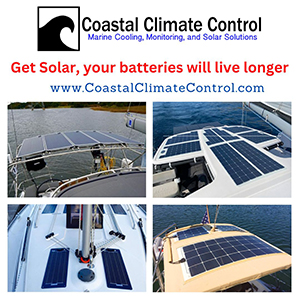
- Media Advertising & Rates
Published by Blue Water Sailing Media, a division of Day Communications, Inc., Middletown, RI
Publisher & Editor: George Day
Blue Water Sailing Media publishes Blue Water Sailing magazine, Multihulls Today and other titles.
Cruising Compass Advertising Sales:
George Day, Newport, RI [email protected] 401-847-7612
- BOATUS and NOAA to Fund Derelict Boat Removals
- In Hurricane Beryl’s Terrible Wake
- Survey of the Week
© 2014 Blue Water Media. All rights reserved. | Admin

The global authority in superyachting
- NEWSLETTERS
- Yachts Home
- The Superyacht Directory
- Yacht Reports
- Brokerage News
- The largest yachts in the world
- The Register
- Yacht Advice
- Yacht Design
- 12m to 24m yachts
- Monaco Yacht Show
- Builder Directory
- Designer Directory
- Interior Design Directory
- Naval Architect Directory
- Yachts for sale home
- Motor yachts
- Sailing yachts
- Explorer yachts
- Classic yachts
- Sale Broker Directory
- Charter Home
- Yachts for Charter
- Charter Destinations
- Charter Broker Directory
- Destinations Home
- Mediterranean
- South Pacific
- Rest of the World
- Boat Life Home
- Owners' Experiences
- Interiors Suppliers
- Owners' Club
- Captains' Club
- BOAT Showcase
- Boat Presents
- Events Home
- World Superyacht Awards
- Superyacht Design Festival
- Design and Innovation Awards
- Young Designer of the Year Award
- Artistry and Craft Awards
- Explorer Yachts Summit
- Ocean Talks
- The Ocean Awards
- BOAT Connect
- Between the bays
- Golf Invitational
- Boat Pro Home
- Superyacht Insight
- Global Order Book
- Premium Content
- Product Features
- Testimonials
- Pricing Plan
- Tenders & Equipment
Founded in 1991, Bluewater offers you more than 30 years of experience and is the only major yachting company with dedicated and experienced teams in the five main sectors of yachting: Yacht Brokerage, Yacht Charter, Yacht Management, Crew Training and Crew Solutions. We take pride in the fact that Bluewater is the only company able to sell, charter and manage yachts on which the crew were recruited and trained in-house.
An international team of experienced professionals, the Bluewater charter specialists have the expertise to ensure you find the right yacht for your charter, also providing tailor-made itineraries in all regions of the world. In addition, the charter management division works alongside owners to globally promote and charter their yachts, maximising potential revenue and minimising stress.
The Bluewater sales division offers unbiased, insightful and accurate advice into every facet of the yacht brokerage process. Whether you are buying or selling, a Bluewater client receives outstanding support and expertise, every step of the way.
Bluewater is based in in Monaco, Antibes, Palma, Zug, Moscow, Fort Lauderdale, Dubai and Hong Kong, ensuring that we can support you 24/7, wherever you are in the world.
Yachts for sale
Yachts for charter.
New interest in plan to link boats from Palm Beach County lakes to Intracoastal and ocean
- The Blueway Trail is a chain of freshwater lakes that runs like a spine down the center of Palm Beach County.
- There is renewed enthusiasm for the idea of connecting the lakes to the Lake Worth Lagoon, the Intracoastal Waterway and the ocean.
- Residents along the C-51 expressed concerns a boat lift would disrupt wildlife through increased boat traffic.
When he is not teaching science at Watson B. Duncan Middle School, Dave Aargaard can often be found on the Blueway Trail, the chain of freshwater lakes that runs like a spine down the center of Palm Beach County.
For about a decade, Aagaard heard about efforts to connect the lakes to the Lake Worth Lagoon, the Intracoastal Waterway and the ocean via a boat lift from the C-51 Canal.
“There is just so much opportunity going from fresh water to blue water,” said Aagaard, a Lake Clarke Shores resident who also organizes fish camps and captains charters aboard his 22-foot Sea Hunt. “You could go to the ocean, you could go fishing, you could go to all the restaurants and bars and sandbars. We love the chain of lakes, but having the best of both worlds would be a dream for all residents.”
Now there is renewed enthusiasm for the idea of connecting the lakes, with talk of possibly moving away from the longstanding boat lift proposal to digging a bypass around the flood-control spillway on the C-51.
The bypass would work like a lock at Spillway Park, said Richard Pinsky, who stepped down as president of the Blueway Trail Inc. to dedicate himself to resurrecting this project. “Your boat would be walked through a little channel, and then with a boardwalk, you would come out on the other side and then there'd be a portage area there as well.”
In 2017, the boat lift at Spillway Park seemed like a done deal with the state Legislature allocating $250,000. But political winds changed amid opposition from some Lake Worth Beach homeowners, and the COVID pandemic appeared to put a stake through the project.
Residents along the C-51 expressed concerns that a boat lift would disrupt wildlife through increased boat traffic.
“They thought there would be hoodlums racing up and down the waterway,” said former West Palm Beach Commissioner Shanon Materio, an early proponent of the boat lift. “Then the cities lost interest.”
Lake Worth Beach Mayor Betty Resch said she is interested in hearing an alternative proposal to the boat lift at Spillway Park. “It’s a beautiful pastoral park,” she said. “If they propose something that made sense, I would certainly entertain it — but only if it makes sense.”
Why the opposition says a bypass is ‘not a smart idea’
On Friday morning after Independence Day, Carl Dahlborg and Joe Duval were fishing at the park. They are at least one generation apart but are aligned in the idea that a boat lift or bypass would ruin the oasis where they catch snook nearly a yard long.
“It just doesn’t seem like a smart idea,” said Dahlborg, 80. “I close my eyes and envision a day in August and they got the boat lift and there are 50 boats lined up in the thunder, lightning and rain.”
Duval said there is a tight-knit community of fishermen and nearby residents — they often throw Spillway parties — who fear a boatlift or bypass would be disastrous for the park.
He also said that only boats less than 24 feet long and can get under the bridges at Interstate 95 and Dixie Highway to access the lift anyway.
“See that bridge there? That ain’t going nowhere,” Duval points toward Dixie. “The only reason they're going to do it is to increase the property value for people in Lake Clarke Shores, so they can say they have saltwater access.”
Ocean access certainly would be a selling point. A feasibility study found waterfront property values could increase up to 40% if a boat lift were installed. There is also an apartment complex planned on the edge of the C-51 on Dixie that is touted as the new and improved gateway to Lake Worth Beach.
Chain of blue lakes in Palm Beach County is postcard worthy
The chain of lakes, aka Blueway Trail , is one of Palm Beach County’s greatest assets.
Motorists on Interstate 95 going through Delray Beach might catch a real-time Florida postcard of a paddleboarder or a kayaker rowing north from Lake Ida along one of the connecting canals. Besides Lake Ida, the Blueway Trail includes adjacent Lake Eden, Lake Osborne in Lake Worth Beach, Lake Clarke and Pine Lake in West Palm Beach. It’s a 30-mile stretch.
Each lake offers something different. Personal watercraft enthusiasts enjoy Lake Ida on most sunny days. Some of the county’s best-known parks abut the lakes with picnic areas, playgrounds, dog parks and, in the case of Lake Osborne, adjacent golf.
Bass, bluegill and cichlids can be found among the cattails and hydrilla for anglers casting from the shore or boat.
“Peacock bass is the one that really keeps me busy. People from all over the world come to catch peacock bass,” Aagaard said. “They’re a really good fighting fish, and they're really pretty.”
Still, the ocean calls, certainly to the 3,500 residents of Lake Clarke Shores, who can get to the C-51 Canal the fastest. For anglers, man-made islands in the lagoon just off the Lake Worth Golf Course teem with snook.
An engineering firm had been selected and preliminary plans had been drawn up for the boat lift with the consent of the South Florida Water Management District. The lift would move the boat — sans captain and passengers — over the flood control structure to the Intracoastal, where it could be boarded again. The plan was to charge boaters to help maintain the lift.
ALSO: Jupiter divers who freed sharks from fishing line may have their theft convictions overturned
“There were a lot of impediments,” Materio said.
From a design aspect, she said, the canal banks around the spillway are steep. No municipality, nor the water management district, wanted to be in charge of operating the lift. And finally, there were homeowners on the Lake Worth Beach side protesting.
What about a public-private partnership for the plan?
Pinsky said the Blueway Trail Inc. was formed in 2018 — the name “chain of lakes” was already taken upstate — in hopes of getting a state designation of a paddleway. “Part of the feature and uniqueness of the trail would be the connectivity of fresh water to salt water, right?” he said.
The effort failed and the wind went out of the sails of the project. Materio lost re-election by 183 votes in 2018 and former Palm Beach County Mayor Dave Kerner, another proponent, now heads up the department of Florida Highway Safety and Motor Vehicles in Tallahassee.
HURRICANE SEASON 2024: What to do with your boat in Florida if a storm approaches
“We have just been unable to get the government financial backing and support that is needed,” said Paul Shalhoub, who succeeded Pinsky as president of Blueway Trail. “So right now, we're switching our focus to see if we can bring a public-private partnership to the table.”
Shaloub, a former mayor of Lake Clarke Shores, said the boat lift is still the dominant proposal because the engineering design and feasibility study is complete.
LAKE WORTH BEACH NEWS: Guy Fieri, star of 'Diners, Drive-ins and Dives', slashes price on Lake Worth Beach home
“We're at the point where everything is back on the table,” he said. “We need to find a way to get the project done, to connect the chain of lakes, and if that's a bypass or boat lift, we're going to figure it out.”
Val Rodriguez, another former Lake Clarke Shores mayor, said there are 1,100 houses on the water in the town with owners who might want a bigger adventure than just the lakes. “You can take a nice long boat ride and end up at Peanut Island — and it promotes the ecosystem,” he said.
Rodriguez pauses, adding, “Obviously, it makes all the houses on this side much more desirable.”
The Key Points at the top of this article were created with the assistance of Artificial Intelligence (AI) and reviewed by a journalist before publication. No other parts of the article were generated using AI. Learn more .
Dyna-Ski Boats custom builds outboard powered water ski boats for recreational skiers and show ski clubs. We have customers all over the world including Malaysia, the Caribbean, Moscow, Russia, the Cayman Islands and Canada. This blog is used to keep readers informed about what is going on at Dyna-Ski and answers questions that are frequently asked. You can also visit www.dyna-ski.com for more information about our boats. Contact Dyna-Ski at [email protected] or call 715-854-7501.
Thursday, January 9, 2014
The true cost of restoring an old 18' hydrodyne or 20' hydrodyne.

No comments:
Post a comment.

COMMENTS
The Blue Water Tracks service is provided free of charge to yacht racing organisations. The service is funded by the philanthropy of the Dunoon Family Trust to ensure the highest level of infrastructure and service quality. Significant resource has been made available in the development of this service, ensuring that every race organiser has ...
Blue Water Tracks Map. Blue Water Tracks Map. ctype html> 2023 Melbourne to Hobart Westcoaster ... 2019 West Offshore Coastal Sprint 1 Race 2019 Melbourne to Stanley Race 2019 Port Fairy Race Training Darwin to Saumlaki Yacht Race 7 Rally Danmark Rundt Singlehand ...
Show boats track. Show boats name. Show race course. Show positions. Show sponsors. Auto update. Hide finished boats. Show Announcement. Blue Water Tracks Map.
2024 Rolex Sydney Hobart Yacht Race | Entries Open. The Cruising Yacht Club of Australia (CYCA) is pleased to invite eligible boats to enter 2024 Rolex Sydney Hobart Yacht Race. The 79th edition of the historic 628-nautical mile blue water classic will start on Sydney Harbour at 1300 hrs AEDT on Thursday 26 December 2024.
The yacht was originally named TryBooking.com after Grant's last business and has since been changed to Blue Water Tracks after one of Grant's new project. The boat is a Moody 54 Deck Saloon. She was purchased new in late 2014 […]
Arcona 435. The Performance Cruiser winner at the 2019 European Yacht of the Year awards, the Arcona 435 is all about the sailing experience. She has genuine potential as a cruiser-racer, but her ...
The Yachts; 2019; Blue Water Tracks; Blue Water Tracks . Formerly known as Trybooking.com, Grant Dunoon and crew retired the Moody 54DS from its last Rolex Sydney Hobart in 2015, after damaging the bow thruster, but finished the 2014 race PHS 16th overall. Last year, he and Sue Bumstead finished Australia's longest ocean race, the 5500nm ...
The 2024 Audi Centre Sydney Blue Water Pointscore consists of six races, opening with the Noakes Sydney Gold Coast Yacht Race and finishing with the Rolex Sydney Hobart Yacht Race. Points accrued across the six races will determine the winners of the overall Pointscores, including: NOTE: Below are the provisional race dates, which will be ...
When choosing Blue Water, you get access to global air freight solutions, courier services and air chartering based on your requirements. Read more Rail Transport Choose rail if you want a reliable service with low environmental impact reducing the transit time from door to door. Read more Courier Transport ...
Blue water in sailing means deep water, and bluewater cruising is a type of ocean cruising and yachting. Sailors who embark on long-range, oceangoing travel are often referred to as bluewater cruisers, and their vessels as bluewater sailing vessels, or bluewater cruisers. "Heading over the horizon" is a common phrase in the sailing world ...
Jeanneau Sun Odyssey 49. For a boat focused on the needs of the lucrative charter market, the Sun Odyssey 49 has proved a remarkably adept bluewater cruiser. A large cockpit, easily managed sailplan and fine all-round performance obviously have something to do with this; cool features like a dedicated sail locker in the bow and a large nav station belowdecks don't hurt either.
Above: A 2022 Silent 62 triple deck catamaran yacht for sale on YachtWorld by Silent Yachts. Photo by Silent Yachts. This beautiful trans-ocean yacht is the ultimate in both luxury and design. With fully solar powered electric motors, it has an unlimited range, zero emission, and noiseless cruising. Multiple layout options offer 4-6 cabins ...
Blue Water Tracks, yacht race tracking. Ocean yacht race and rally satellite tracking with public race map, bio's, boat and crew photos. ... Perfect for all ocean yacht races... Keywords: race, Satellite, Yacht, trackers, tracking, blue tracker, yacht tracker, blue tracks. https://bluewatertracks.com Safety status. Safe. Server location ...
The 10 best bluewater boats. 1. Westsail 32. Photo credit: SailboatData.com. The Westsail 32 is one of the most iconic bluewater cruisers and 19 have set out to cross the Pacific in the PPJ rally since 2009. In 1973, this small cruising sailboat garnered a 4-page spread in Time magazine.
The legendary bluewater sailboats under 50 feet include Rustler 36, Tartan 37, Hallberg-Rassy 42F, Baba 30, Island Packet 38, Pacific Seacraft 37, Valiant 40, Najad 370, Moody 42, Halberg-Rassy 39, Sweden Yachts 45, Boreal 47, Amel Super Maramu, Outbound 44, Hylas 49, Malo 46, and Garcia Exploration 45. These legendary sailboats have earned ...
Finally, a blue water cruiser must have a safe limit of positive stability (LPS)—at least 120 degrees, although higher is better—to prevent it from capsizing in heavy seas. LPS is the heel angle at which the hull and keel stop resisting the capsizing forces of the wind and waves and actually abet them until the boat is completely inverted.
Kadey-Krogen pioneered the long-distance trawler in 1977 with the introduction of the venerable 42 and every boat launched since then represents a culmination of expertise and a perpetual quest for perfection for our singular objective. ... Each and every Krogen model from 44 to 70 feet is designed to efficiently go through the water in all ...
In this article, we've handpicked the top 7 legendary solo bluewater sailboats worth considering for their excellent track records. The most legendary solo bluewater sailboats are the Contessa 32, Westsail 32, Hallberg-Rassy 42F, Pacific Seacraft 37, Island Packet 38, Tayana 42, and Amel 54. These boats have it all: from robust designs to a ...
Rodby [email protected] +45 7913 4688 Read more. Ronne [email protected] +45 4212 4620 Read more. Skagen [email protected] +45 7913 4758 Read more. Sonderborg [email protected] +45 5230 8246 Read more. Taulov [email protected] +45 7913 6000 Read more.
Two minor boat accidents were reported. "Blue Angels Weekend is a much-anticipated tradition for so many people in our area," said FWC Northwest Regional Commander Maj. Robby Creech.
A Guide to 10 Great Blue Water Boats. Every veteran cruiser has his or her list of favorite cruising boats and, because cost is often an issue for many sailors, a lot of those boats will fall in the under-40-foot category. There are certainly many sweet designs under 40 feet that range from the venerable Crealock 37 to the futuristic Outremer ...
Bluewater. Founded in 1991, Bluewater offers you more than 30 years of experience and is the only major yachting company with dedicated and experienced teams in the five main sectors of yachting: Yacht Brokerage, Yacht Charter, Yacht Management, Crew Training and Crew Solutions. We take pride in the fact that Bluewater is the only company able ...
"There is just so much opportunity going from fresh water to blue water," said Aagaard, a Lake Clarke Shores resident who also organizes fish camps and captains charters aboard his 22-foot Sea ...
He has been restoring - here is the cost so far, without gel/paint. All the labor he has provided. $1450 - largest expense for 7 Bluewater 26 Coosa boards 1/2" x 4 x 8'. Transom and stringers have eaten 3+ sheets. The 3+ left should be enough to do the floor. $460 - 6 1" thick Divinycell H80 core material 4' x 32".